Itinerary
Auckland is called the City of Sails, and visitors flying in will see why. On the East Coast is the Waitemata Harbour—a Māori word meaning sparkling waters—which is bordered by the Hauraki Gulf, an aquatic playground peppered with small islands where many Aucklanders can be found “mucking around in boats.”Not surprisingly, Auckland has some 70,000 boats. About one in four households in Auckland has a seacraft of some kind, and there are 102 beaches within an hour’s drive; during the week many are quite empty. Even the airport is by the water; it borders the Manukau Harbour, which also takes its name from the Māori language and means solitary bird.According to Māori tradition, the Auckland isthmus was originally peopled by a race of giants and fairy folk. When Europeans arrived in the early 19th century, however, the Ngāti-Whātua tribe was firmly in control of the region. The British began negotiations with the Ngāti-Whātua in 1840 to purchase the isthmus and establish the colony’s first capital. In September of that year the British flag was hoisted to mark the township’s foundation, and Auckland remained the capital until 1865, when the seat of government was moved to Wellington. Aucklanders expected to suffer from the shift; it hurt their pride but not their pockets. As the terminal for the South Sea shipping routes, Auckland was already an established commercial center. Since then the urban sprawl has made this city of approximately 1.3 million people one of the world’s largest geographically.A couple of days in the city will reveal just how developed and sophisticated Auckland is—the Mercer City Survey 2012 saw it ranked as the third-highest city for quality of life—though those seeking a New York in the South Pacific will be disappointed. Auckland is more get-up and go-outside than get-dressed-up and go-out. That said, most shops are open daily, central bars and a few nightclubs buzz well into the wee hours, especially Thursday through Saturday, and a mix of Māori, Pacific people, Asians, and Europeans contributes to the cultural milieu. Auckland has the world’s largest single population of Pacific Islanders living outside their home countries, though many of them live outside the central parts of the city and in Manukau to the south. The Samoan language is the second most spoken in New Zealand. Most Pacific people came to New Zealand seeking a better life. When the plentiful, low-skilled work that attracted them dried up, the dream soured, and the population has suffered with poor health and education. Luckily, policies are now addressing that, and change is slowly coming. The Pacifica Festival in March is the region’s biggest cultural event, attracting thousands to Western Springs. The annual Pacific Island Secondary Schools’ Competition, also in March, sees young Pacific Islander and Asian students compete in traditional dance, drumming, and singing. This event is open to the public.At the geographical center of Auckland city is the 1,082-foot Sky Tower, a convenient landmark for those exploring on foot and some say a visible sign of the city’s naked aspiration. It has earned nicknames like the Needle and the Big Penis—a counterpoint to a poem by acclaimed New Zealand poet James K. Baxter, which refers to Rangitoto Island as a clitoris in the harbor.The Waitemata Harbour has become better known since New Zealand staged its first defense of the America’s Cup in 2000 and the successful Louis Vuitton Pacific Series in early 2009. The first regatta saw major redevelopment of the waterfront. The area, where many of the city’s most popular bars, cafés, and restaurants are located, is now known as Viaduct Basin or, more commonly, the Viaduct. A recent expansion has created another area, Wynyard Quarter, which is slowly adding restaurants.These days, Auckland is still considered too bold and brash for its own good by many Kiwis who live “south of the Bombay Hills,” the geographical divide between Auckland and the rest of New Zealand (barring Northland). “Jafa,” an acronym for “just another f—ing Aucklander,” has entered the local lexicon; there’s even a book out called Way of the Jafa: A Guide to Surviving Auckland and Aucklanders. A common complaint is that Auckland absorbs the wealth from the hard work of the rest of the country. Most Aucklanders, on the other hand, still try to shrug and see it as the parochial envy of those who live in small towns. But these internal identity squabbles aren’t your problem. You can enjoy a well-made coffee in almost any café, or take a walk on a beach—knowing that within 30 minutes’ driving time you could be cruising the spectacular harbor, playing a round at a public golf course, or even walking in subtropical forest while listening to the song of a native tûî bird.
Day itinerary:
Known as the ‘City of Sails’, its two harbours will tempt you with waterfront walks and the chance to breathe fresh sea air deep into your lungs while absorbing spectacular views of Auckland’s grand harbour bridge’s span. Take in the true scale of Auckland’s magnificent cityscape by ascending 192 metres to the Sky Tower and looking out over the city’s gleaming silver towers which reflect on the abundant waters below. Views over the bay and adjacent islands await and you can share elegant cocktails at this dizzying height above the mingling yachts of Viaduct Harbour. Immerse yourself in the rich history and culture of the area at Auckland Art Gallery Toi o Tāmaki. Set beside tranquil fountains and handsomely landscaped flowerbeds of Albert Park, the French-Renaissance building houses, New Zealand’s most extensive art collection and exhibits works from Māori and Pacific artists. New Zealand is world-renowned for its captivating natural scenery and day trips across the sparkling bays to nearby islands like Waiheke Tiritiri Matangi and Rangitoto are always tempting. Discover lava caves grape-laden vineyards and flourishing wildlife in the Hauraki Gulf’s islands. You’ll also find an exceptional 360-degree panorama over the city to the horizon beyond from the heights of ancient Mount Eden. The spectacular dormant volcano rises improbably from a city suburb and also lends its name to Eden Park – the unusual translucent stadium of New Zealand’s mighty All Blacks.
Auckland is called the City of Sails, and visitors flying in will see why. On the East Coast is the Waitemata Harbour—a Māori word meaning sparkling waters—which is bordered by the Hauraki Gulf, an aquatic playground peppered with small islands where many Aucklanders can be found “mucking around in boats.”Not surprisingly, Auckland has some 70,000 boats. About one in four households in Auckland has a seacraft of some kind, and there are 102 beaches within an hour’s drive; during the week many are quite empty. Even the airport is by the water; it borders the Manukau Harbour, which also takes its name from the Māori language and means solitary bird.According to Māori tradition, the Auckland isthmus was originally peopled by a race of giants and fairy folk. When Europeans arrived in the early 19th century, however, the Ngāti-Whātua tribe was firmly in control of the region. The British began negotiations with the Ngāti-Whātua in 1840 to purchase the isthmus and establish the colony’s first capital. In September of that year the British flag was hoisted to mark the township’s foundation, and Auckland remained the capital until 1865, when the seat of government was moved to Wellington. Aucklanders expected to suffer from the shift; it hurt their pride but not their pockets. As the terminal for the South Sea shipping routes, Auckland was already an established commercial center. Since then the urban sprawl has made this city of approximately 1.3 million people one of the world’s largest geographically.A couple of days in the city will reveal just how developed and sophisticated Auckland is—the Mercer City Survey 2012 saw it ranked as the third-highest city for quality of life—though those seeking a New York in the South Pacific will be disappointed. Auckland is more get-up and go-outside than get-dressed-up and go-out. That said, most shops are open daily, central bars and a few nightclubs buzz well into the wee hours, especially Thursday through Saturday, and a mix of Māori, Pacific people, Asians, and Europeans contributes to the cultural milieu. Auckland has the world’s largest single population of Pacific Islanders living outside their home countries, though many of them live outside the central parts of the city and in Manukau to the south. The Samoan language is the second most spoken in New Zealand. Most Pacific people came to New Zealand seeking a better life. When the plentiful, low-skilled work that attracted them dried up, the dream soured, and the population has suffered with poor health and education. Luckily, policies are now addressing that, and change is slowly coming. The Pacifica Festival in March is the region’s biggest cultural event, attracting thousands to Western Springs. The annual Pacific Island Secondary Schools’ Competition, also in March, sees young Pacific Islander and Asian students compete in traditional dance, drumming, and singing. This event is open to the public.At the geographical center of Auckland city is the 1,082-foot Sky Tower, a convenient landmark for those exploring on foot and some say a visible sign of the city’s naked aspiration. It has earned nicknames like the Needle and the Big Penis—a counterpoint to a poem by acclaimed New Zealand poet James K. Baxter, which refers to Rangitoto Island as a clitoris in the harbor.The Waitemata Harbour has become better known since New Zealand staged its first defense of the America’s Cup in 2000 and the successful Louis Vuitton Pacific Series in early 2009. The first regatta saw major redevelopment of the waterfront. The area, where many of the city’s most popular bars, cafés, and restaurants are located, is now known as Viaduct Basin or, more commonly, the Viaduct. A recent expansion has created another area, Wynyard Quarter, which is slowly adding restaurants.These days, Auckland is still considered too bold and brash for its own good by many Kiwis who live “south of the Bombay Hills,” the geographical divide between Auckland and the rest of New Zealand (barring Northland). “Jafa,” an acronym for “just another f—ing Aucklander,” has entered the local lexicon; there’s even a book out called Way of the Jafa: A Guide to Surviving Auckland and Aucklanders. A common complaint is that Auckland absorbs the wealth from the hard work of the rest of the country. Most Aucklanders, on the other hand, still try to shrug and see it as the parochial envy of those who live in small towns. But these internal identity squabbles aren’t your problem. You can enjoy a well-made coffee in almost any café, or take a walk on a beach—knowing that within 30 minutes’ driving time you could be cruising the spectacular harbor, playing a round at a public golf course, or even walking in subtropical forest while listening to the song of a native tûî bird.
Day itinerary:
Known as the ‘City of Sails’, its two harbours will tempt you with waterfront walks and the chance to breathe fresh sea air deep into your lungs while absorbing spectacular views of Auckland’s grand harbour bridge’s span. Take in the true scale of Auckland’s magnificent cityscape by ascending 192 metres to the Sky Tower and looking out over the city’s gleaming silver towers which reflect on the abundant waters below. Views over the bay and adjacent islands await and you can share elegant cocktails at this dizzying height above the mingling yachts of Viaduct Harbour. Immerse yourself in the rich history and culture of the area at Auckland Art Gallery Toi o Tāmaki. Set beside tranquil fountains and handsomely landscaped flowerbeds of Albert Park, the French-Renaissance building houses, New Zealand’s most extensive art collection and exhibits works from Māori and Pacific artists. New Zealand is world-renowned for its captivating natural scenery and day trips across the sparkling bays to nearby islands like Waiheke Tiritiri Matangi and Rangitoto are always tempting. Discover lava caves grape-laden vineyards and flourishing wildlife in the Hauraki Gulf’s islands. You’ll also find an exceptional 360-degree panorama over the city to the horizon beyond from the heights of ancient Mount Eden. The spectacular dormant volcano rises improbably from a city suburb and also lends its name to Eden Park – the unusual translucent stadium of New Zealand’s mighty All Blacks.
The population center of the Bay of Plenty, Tauranga is one of New Zealand’s fastest-growing cities. Along with its neighbor, Whakatane, this seaside city claims to be one of the country’s sunniest towns. Unlike most local towns, Tauranga doesn’t grind to a halt in the off-season, because it has one of the busiest ports in the country, and the excellent waves at the neighboring beach resort of Mount Maunganui—just across Tauranga’s harbor bridge—always draw surfers and holiday folk.
Day itinerary:
Tauranga is New Zealand’s sunny capital – with wide sweeping beaches and surfers curling across cresting waves. Climb to the top for spectacular views of the natural harbour or take winding coastal footpaths to explore the unfolding scenery. An entry point to the vast indent of the Bay of Plenty the volcanic peak of Mount Maunganui is a fittingly dramatic welcome. Brooding geothermal energy creates spectacular natural attractions across this region while plunging waterfalls and fascinating Maori culture ensures that the Bay of Plenty has a lot to offer visitors. Said to receive New Zealand’s highest amount of sunshine the hanging kiwi citrus fruit and avocados add an exotic touch to the area’s landscape – especially around Te Puke. Vibrant teal and orange colours await at the stunning geothermal area of Whakarewarewa Thermal Reserve where mud pools bubble and steam rises from the earth. There are more hot pools and some of the country’s best scenery at Lake Rotoiti – where you can kayak across the smooth surface and enter a cave that glows gentle blue with its darkened roof illuminated by glittering glow worms. Enter New Zealand’s fantasy world with a visit to some of the country’s celebrated filming spots – which have featured as doubles for JRR Tolkien’s Middle Earth’s fantasy settings. Offshore the wonderful White Island’s volcanic cone peeks from the waves and New Zealand’s most active volcano certainly knows how to put on a show belching out smoke across the water.
With a population of around 35,000 and located on the north island, Gisborne exudes history at every turn. Maori for “Great standing place of Kiwa”, Kiwa was a leading figure aboard the Maori ancestral canoe, Takitimu, which ran aground in Gisborne around 1450 AD. After landing, Kiwa became a coastal guardian, eventually marrying Parawhenuamea, the keeper of the streams. The union point of three rivers and the first place to see the sun, the city is filled with light and laugher and gracefully squeezes surfer’s beaches with the district’s colonial past. Captain Cook made his first landfall here, John Harris set up his first trading station in the then village and today, Gisborn is the major centre of Maori cultural life.Suffice to say then that the city is a watery wonderland. With its picture perfect beaches, what savvy traveller does not want to add being among the first people in the world to say they have watched the sky change colour as the sun bursts from out of the sea. A place of nature, spectacular beach cliff views are all just part and parcel of everyday life here, and easy walks from the centre of town to the Titirangi Reserve will award you with yet more unbelievable 180˚ vistas from Poverty Bay to Gisborne City; stretch your eyes with the panorama, while stretching your legs on one of the many enjoyable walks.A perfect place to stroll, amble and wander, like much of New Zealand Gisborne keeps a healthy respect for history and nature and enjoys a very laid back feel.
Day itinerary:
With a population of around 35 000 and located on the north island Gisborne exudes history at every turn. Maori for “Great standing place of Kiwa” Kiwa was a leading figure aboard the Maori ancestral canoe Takitimu which ran aground in Gisborne around 1450 AD. After landing Kiwa became a coastal guardian eventually marrying Parawhenuamea the keeper of the streams. The union point of three rivers and the first place to see the sun the city is filled with light and laugher and gracefully squeezes surfer’s beaches with the district’s colonial past. Captain Cook made his first landfall here John Harris set up his first trading station in the then village and today Gisborn is the major centre of Maori cultural life.Suffice to say then that the city is a watery wonderland. With its picture perfect beaches what savvy traveller does not want to add being among the first people in the world to say they have watched the sky change colour as the sun bursts from out of the sea. A place of nature spectacular beach cliff views are all just part and parcel of everyday life here and easy walks from the centre of town to the Titirangi Reserve will award you with yet more unbelievable 180˚ vistas from Poverty Bay to Gisborne City stretch your eyes with the panorama while stretching your legs on one of the many enjoyable walks.A perfect place to stroll amble and wander like much of New Zealand Gisborne keeps a healthy respect for history and nature and enjoys a very laid back feel.
The earthquake that struck Napier at 10:46 am on February 3, 1931, was—at 7.8 on the Richter scale—the largest quake ever recorded in New Zealand. The coastline was wrenched upward several feet. Almost all the town’s brick buildings collapsed; many people were killed on the footpaths as they rushed outside. The quake triggered fires throughout town, and with water mains shattered, little could be done to stop the blazes that devoured the remaining wooden structures. Only a few buildings survived (the Public Service Building with its neoclassical pillars is one), and the death toll was well over 100.The surviving townspeople set up tents and cookhouses in Nelson Park, and then tackled the city’s reconstruction at a remarkable pace. In the rush to rebuild, Napier went mad for art deco, the bold, geometric style that had burst on the global design scene in 1925. Now a walk through the art deco district, concentrated between Emerson, Herschell, Dalton, and Browning streets, is a stylistic immersion. The decorative elements are often above the ground floors, so keep your eyes up.
Day itinerary:
Sip the fine wines of legendary producers visit Cape Kidnappers’ crowds of birdlife and wander the stylish streets of the world’s art deco capital during your time in handsome Napier. Located on the huge arc of Hawke’s Bay Napier enjoys a generous Mediterranean style climate and a breezy cafe culture. A green outdoor town wander Marine Parade which borders the rich blue Pacific and invites you to stroll along a tree-lined two-mile seafront. Take the gentle hike up to Bluff Hill for panoramic views over the lively Napier Port and out towards Cape Kidnappers – given its name following a clash between Captain Cook’s settlers and the local Maori population. Here you’ll encounter one of the world’s largest mainland gannet colonies creating a colourful cacophony by the sea. Set on sheer cliffs the golden-headed birds are an incredible sight swirling overhead and dancing before you. The city’s renowned Art Deco architecture glows in the sunshine of New Zealand’s North Island. Built following the devastating 7.8 magnitude earthquake which ripped through the region in 1931. The rebuild in the architectural fashion of the time has left an authentic treasure-trove of 30s style buildings. Grapes thrive in the warm dry climate of Napier and Hawke’s Bay which is one of New Zealand’s oldest wine regions. Swirl glasses in waterfront bars or head out to walk among the vineyards of pinot gris and syrah grapes learning of the climate conditions that help add sophisticated flavour to every bottle.
The earthquake that struck Napier at 10:46 am on February 3, 1931, was—at 7.8 on the Richter scale—the largest quake ever recorded in New Zealand. The coastline was wrenched upward several feet. Almost all the town’s brick buildings collapsed; many people were killed on the footpaths as they rushed outside. The quake triggered fires throughout town, and with water mains shattered, little could be done to stop the blazes that devoured the remaining wooden structures. Only a few buildings survived (the Public Service Building with its neoclassical pillars is one), and the death toll was well over 100.The surviving townspeople set up tents and cookhouses in Nelson Park, and then tackled the city’s reconstruction at a remarkable pace. In the rush to rebuild, Napier went mad for art deco, the bold, geometric style that had burst on the global design scene in 1925. Now a walk through the art deco district, concentrated between Emerson, Herschell, Dalton, and Browning streets, is a stylistic immersion. The decorative elements are often above the ground floors, so keep your eyes up.
Day itinerary:
Sip the fine wines of legendary producers visit Cape Kidnappers’ crowds of birdlife and wander the stylish streets of the world’s art deco capital during your time in handsome Napier. Located on the huge arc of Hawke’s Bay Napier enjoys a generous Mediterranean style climate and a breezy cafe culture. A green outdoor town wander Marine Parade which borders the rich blue Pacific and invites you to stroll along a tree-lined two-mile seafront. Take the gentle hike up to Bluff Hill for panoramic views over the lively Napier Port and out towards Cape Kidnappers – given its name following a clash between Captain Cook’s settlers and the local Maori population. Here you’ll encounter one of the world’s largest mainland gannet colonies creating a colourful cacophony by the sea. Set on sheer cliffs the golden-headed birds are an incredible sight swirling overhead and dancing before you. The city’s renowned Art Deco architecture glows in the sunshine of New Zealand’s North Island. Built following the devastating 7.8 magnitude earthquake which ripped through the region in 1931. The rebuild in the architectural fashion of the time has left an authentic treasure-trove of 30s style buildings. Grapes thrive in the warm dry climate of Napier and Hawke’s Bay which is one of New Zealand’s oldest wine regions. Swirl glasses in waterfront bars or head out to walk among the vineyards of pinot gris and syrah grapes learning of the climate conditions that help add sophisticated flavour to every bottle.
New Zealand’s capital is, arguably, the country’s most cosmopolitan metropolis. It’s world-class Te Papa Tongarewa-Museum of New Zealand is a don’t-miss attraction, and the burgeoning film industry led, of course, by the Lord of the Rings extravaganzas has injected new life into the local arts scene. Attractive and compact enough to be explored easily on foot, Wellington is a booming destination. Modern high-rise buildings gaze over Port Nicholson, surely one of the finest natural anchorages in the world. Known to local Māori as The Great Harbor of Tara, its two massive arms form the jaws of the fish of Maui from Māori legend. Sometimes referred to as the windy city, Wellington has been the seat of New Zealand’s government since 1865.
Day itinerary:
Sprawling around a hook-shaped peninsula Wellington is a vibrant and energetic seaside capital. A compact well-stocked city of buzzing bars and chatting cafes New Zealand’s capital is a bright and breezy place with an infectious easy-going atmosphere. Known as the creative hub of the South Pacific there are shows to see art installations to enjoy and rich flavours to savour here. The sounds of rare and beautiful birdlife fill the hills around the city and the bush of the green belt provides easy-to-access sanctuary strolls and cycle rides. The Botanical Gardens break up the buildings even more while an iconic cherry-red cable car rumbles up Wellington’s slope to the city’s best viewpoint looking out over the city’s scenic harbour from above. Zealandia has provided an urban home for rare and endangered birdlife bringing many species back from the brink. Varied museums cover everything from Maori traditions to earthquake simulations and even the real-life Kraken – a displayed colossal squid. Wellington is only New Zealand’s third-biggest city but spend some time here and you’ll realise that’s a blessing. The wines grown nearby are revered and the city’s craft beers are also making waves. Wander the breezy waterfront and admire the surfers riding the wind-whipped rollers of the self-proclaimed ‘coolest little capital in the world’.
Day itinerary:
When asked to describe his homeland, (Lord of the Rings Trilogy and The Hobbit director) Peter Jackson said “New Zealand is not a small country but a large village” and never a truer word was spoken about New Plymouth. Named after Plymouth in England when the first British settlers arrived in 1841, the city is a hybrid of traditions. Treasure, stories and culture fuse perfectly together with coastal walkways, botanic gardens and award winning golf-courses in this bubbly, artsy city.Located in the Taranaki Region on New Zealand’s North Island, New Plymouth has won multiple awards for its positive attitude towards pedestrians and cyclists and community sustainability. Ruled by the great outdoors and more notably Mount Taranaki, this majestic 8261 feet/2,518 metre snow-capped active volcano looms over the city with the ever-present threat of eruption (although the last eruption dates back to 1814), thus making the city and its surroundings a veritable haven for those who love outdoor pursuits. Rising above the clouds, the volcano beckons walkers and those who do make it to the top are compensated with spectacular sea vistas from their privileged position, perched high above the city.
The maritime township of Picton (population 4,000) lies at the head of Queen Charlotte Sound and is the arrival point for ferries from the North Island, as well as a growing number of international cruise ships. It plays a major role in providing services and transport by water taxi to a multitude of remote communities in the vast area of islands, peninsulas, and waterways that make up the Marlborough Sounds Maritime Park. There’s plenty to do in town, with crafts markets in summer, historical sights to see, and walking tracks to scenic lookouts over the sounds. The main foreshore is lined by London Quay, which looks up Queen Charlotte Sound to the bays beyond. High Street runs down to London Quay from the hills, and between them these two streets make up the center of town.
Day itinerary:
Pretty Picton is a beautiful harbour town lying on the cusp of the mighty scenery of the Marlborough Sounds Maritime Park and providing an attractive link between New Zealand’s two main islands. The journey into the scenic Queen Charlotte Sound is a vista that only New Zealand can provide as you sail through crumpled green peaks and folding hills towards Picton’s little flotillas of yachts and endearing waterfront appeal. You could easily spend days here browsing art studios and galleries nursing freshly ground coffees and watching the undulations of the bay’s waters from Picton’s waterfront eateries. Or enjoying the coastal location and sea views while wandering Picton Memorial Park among palm trees bright flowers and benches that sit before sweeping views of the Sound. The Marlborough Sounds are 1 500 km of eye-rubbingly beautiful scenery formed by submerged valleys cascading down to the sea’s waters. With its multitude of bays coves and islands you’ll find no shortage of walks as well as plenty of opportunities to get out onto the calm water and push through the gentle waves in kayaks. Or sit back and enjoy weaving through the scenery from the comfort of a sailboat looking out for abundant wildlife like penguins dolphins and seals. Vineyards coat the sheltered land between the mountains and ocean – generating the perfect climate for cultivation. Sample a glass of the renowned Sauvignon Blanc from the Blenheim wine region nearby for a taste of the fruitful produce.
Straddling the Derwent River at the foot of Mt. Wellington’s forested slopes, Hobart was founded as a penal settlement in 1803. It’s the second-oldest city in the country after Sydney, and it certainly rivals its mainland counterpart as Australia’s most beautiful state capital. Close-set colonial brick-and-sandstone shops and homes line the narrow, quiet streets, creating a genteel setting for this historic city of 215,000. Life revolves around the broad Derwent River port, one of the deepest harbors in the world. Here warehouses that once stored Hobart’s major exports of fruit, wool, and corn and products from the city’s former whaling fleet still stand alongside the wharf today.Hobart sparkles between Christmas and New Year’s—summer Down Under—during the annual Sydney-to-Hobart yacht race. The event dominates conversations among Hobart’s citizens, who descend on Constitution Dock to welcome the yachts and join in the boisterous festivities of the crews. The New Year also coincides with the Tastes of Tasmania Festival, when the dockside area comes alive with the best of Tasmanian food and wine on offer in numerous cafés, bars, and waterfront stalls. Otherwise, Hobart is a placid city whose nightlife is largely confined to excellent restaurants, jazz clubs, and the action at the Wrest Point Casino in Sandy Bay.The Hobart Tasmanian Travel and Information Centre hours are weekdays 8:30–5:30 and Saturday 9–5.
Day itinerary:
Mount Wellington’s looming cloud-wisped form is an ever-present sight as you explore booming Hobart the cosmopolitan capital of Australia’s most southerly state. A former British penal colony nowadays Australia’s second-oldest city is a place to live the free and easy life. Encircled by dramatic cliffs landscaped gardens and rolling vineyards Hobart is also well stacked with cultural pursuits including museums and respected – if controversial – galleries plastering new and old art to their walls. With fresh sea breezes and a fabulous location Hobart is a creative place where you can browse the produce of local artisans in Saturday’s massive Salamanca Market – which draws visitors from all across Tasmania and beyond. Eat at waterfront restaurants or rise up Mount Wellington’s slopes to appreciate the remoteness of Hobart’s location. From this elevated platform you can look down across views of flowing forests undulating mountains and endless ocean swallowing up the city. Further away animal sanctuaries introduce you to the island’s famous inhabitants including the famous Tasmanian devil. Thirsty? Hobart has a long brewing tradition – so enjoy a refreshing ale poured from the country’s oldest brewery. The climate’s blend of generous sunshine and cool Antarctic breezes helps Hobart to produce its acclaimed wines and thick clumps of pinot noir grapes hang from vineyards dotted along the valleys nearby. Taste the wines accompanied by a platter of artisan cheese and sausage.
Straddling the Derwent River at the foot of Mt. Wellington’s forested slopes, Hobart was founded as a penal settlement in 1803. It’s the second-oldest city in the country after Sydney, and it certainly rivals its mainland counterpart as Australia’s most beautiful state capital. Close-set colonial brick-and-sandstone shops and homes line the narrow, quiet streets, creating a genteel setting for this historic city of 215,000. Life revolves around the broad Derwent River port, one of the deepest harbors in the world. Here warehouses that once stored Hobart’s major exports of fruit, wool, and corn and products from the city’s former whaling fleet still stand alongside the wharf today.Hobart sparkles between Christmas and New Year’s—summer Down Under—during the annual Sydney-to-Hobart yacht race. The event dominates conversations among Hobart’s citizens, who descend on Constitution Dock to welcome the yachts and join in the boisterous festivities of the crews. The New Year also coincides with the Tastes of Tasmania Festival, when the dockside area comes alive with the best of Tasmanian food and wine on offer in numerous cafés, bars, and waterfront stalls. Otherwise, Hobart is a placid city whose nightlife is largely confined to excellent restaurants, jazz clubs, and the action at the Wrest Point Casino in Sandy Bay.The Hobart Tasmanian Travel and Information Centre hours are weekdays 8:30–5:30 and Saturday 9–5.
Day itinerary:
Mount Wellington’s looming cloud-wisped form is an ever-present sight as you explore booming Hobart the cosmopolitan capital of Australia’s most southerly state. A former British penal colony nowadays Australia’s second-oldest city is a place to live the free and easy life. Encircled by dramatic cliffs landscaped gardens and rolling vineyards Hobart is also well stacked with cultural pursuits including museums and respected – if controversial – galleries plastering new and old art to their walls. With fresh sea breezes and a fabulous location Hobart is a creative place where you can browse the produce of local artisans in Saturday’s massive Salamanca Market – which draws visitors from all across Tasmania and beyond. Eat at waterfront restaurants or rise up Mount Wellington’s slopes to appreciate the remoteness of Hobart’s location. From this elevated platform you can look down across views of flowing forests undulating mountains and endless ocean swallowing up the city. Further away animal sanctuaries introduce you to the island’s famous inhabitants including the famous Tasmanian devil. Thirsty? Hobart has a long brewing tradition – so enjoy a refreshing ale poured from the country’s oldest brewery. The climate’s blend of generous sunshine and cool Antarctic breezes helps Hobart to produce its acclaimed wines and thick clumps of pinot noir grapes hang from vineyards dotted along the valleys nearby. Taste the wines accompanied by a platter of artisan cheese and sausage.
Consistently rated among the “world’s most livable cities” in quality-of-life surveys, Melbourne is built on a coastal plain at the top of the giant horseshoe of Port Phillip Bay. The city center is an orderly grid of streets where the state parliament, banks, multinational corporations, and splendid Victorian buildings that sprang up in the wake of the gold rush now stand. This is Melbourne’s heart, which you can explore at a leisurely pace in a couple of days.In Southbank, one of the newer precincts south of the city center, the Southgate development of bars, restaurants, and shops has refocused Melbourne’s vision on the Yarra River. Once a blighted stretch of factories and run-down warehouses, the southern bank of the river is now a vibrant, exciting part of the city, and the river itself is finally taking its rightful place in Melbourne’s psyche.Just a hop away, Federation Square—with its host of galleries—has become a civic landmark for Melburnians. Stroll along the Esplanade in the suburb of St. Kilda, amble past the elegant houses of East Melbourne, enjoy the shops and cafés in Fitzroy or Carlton, rub shoulders with locals at the Victoria Market, nip into the Windsor for afternoon tea, or rent a canoe at Studley Park to paddle along one of the prettiest stretches of the Yarra—and you may discover Melbourne’s soul as well as its heart.
Day itinerary:
The smells of freshly ground artisan coffees fill the streets of this hip youthful city which is generously sprinkled with fine dining establishments art galleries and absorbing museums. With an airy outdoor lifestyle Melbourne is a vibrant global hub of fashion fun and festivities. Multicultural and diverse Victoria’s capital is crisscrossed by narrow alleys and splashed with street art. It’s fair to say Melbourne’s bearded baristas take their coffees seriously. Settle in to sample the unique coffee culture that is an essential part of Melbourne life. Looking for something a little stronger? The city’s rooftop bars come alive with clinking cocktails as the sun sets. A world leader in culinary arts take your seat at award-winning restaurants and sample world foods alongside delicious wines cultivated in the vineyards of the surrounding valleys. Savour a glass while cruising the arching Yarra River for an unbeatable introduction to Melbourne. An outdoor city it’s no surprise that Melbourne is one of Australia’s sporting giants. The vast bowl of Melbourne Cricket Ground serves as the city’s sporting cathedral – squeezing in over 100 000 fans and hosting various sports on its hallowed oval turf. Whether it’s the rumble of hoofs during the Melbourne Cup revs of engines during the Formula One or thwacks of tennis balls during the Australian Open – few places can boast such a comprehensive list of high-profile sporting appeals.
Consistently rated among the “world’s most livable cities” in quality-of-life surveys, Melbourne is built on a coastal plain at the top of the giant horseshoe of Port Phillip Bay. The city center is an orderly grid of streets where the state parliament, banks, multinational corporations, and splendid Victorian buildings that sprang up in the wake of the gold rush now stand. This is Melbourne’s heart, which you can explore at a leisurely pace in a couple of days.In Southbank, one of the newer precincts south of the city center, the Southgate development of bars, restaurants, and shops has refocused Melbourne’s vision on the Yarra River. Once a blighted stretch of factories and run-down warehouses, the southern bank of the river is now a vibrant, exciting part of the city, and the river itself is finally taking its rightful place in Melbourne’s psyche.Just a hop away, Federation Square—with its host of galleries—has become a civic landmark for Melburnians. Stroll along the Esplanade in the suburb of St. Kilda, amble past the elegant houses of East Melbourne, enjoy the shops and cafés in Fitzroy or Carlton, rub shoulders with locals at the Victoria Market, nip into the Windsor for afternoon tea, or rent a canoe at Studley Park to paddle along one of the prettiest stretches of the Yarra—and you may discover Melbourne’s soul as well as its heart.
Day itinerary:
The smells of freshly ground artisan coffees fill the streets of this hip youthful city which is generously sprinkled with fine dining establishments art galleries and absorbing museums. With an airy outdoor lifestyle Melbourne is a vibrant global hub of fashion fun and festivities. Multicultural and diverse Victoria’s capital is crisscrossed by narrow alleys and splashed with street art. It’s fair to say Melbourne’s bearded baristas take their coffees seriously. Settle in to sample the unique coffee culture that is an essential part of Melbourne life. Looking for something a little stronger? The city’s rooftop bars come alive with clinking cocktails as the sun sets. A world leader in culinary arts take your seat at award-winning restaurants and sample world foods alongside delicious wines cultivated in the vineyards of the surrounding valleys. Savour a glass while cruising the arching Yarra River for an unbeatable introduction to Melbourne. An outdoor city it’s no surprise that Melbourne is one of Australia’s sporting giants. The vast bowl of Melbourne Cricket Ground serves as the city’s sporting cathedral – squeezing in over 100 000 fans and hosting various sports on its hallowed oval turf. Whether it’s the rumble of hoofs during the Melbourne Cup revs of engines during the Formula One or thwacks of tennis balls during the Australian Open – few places can boast such a comprehensive list of high-profile sporting appeals.
Consistently rated among the “world’s most livable cities” in quality-of-life surveys, Melbourne is built on a coastal plain at the top of the giant horseshoe of Port Phillip Bay. The city center is an orderly grid of streets where the state parliament, banks, multinational corporations, and splendid Victorian buildings that sprang up in the wake of the gold rush now stand. This is Melbourne’s heart, which you can explore at a leisurely pace in a couple of days.In Southbank, one of the newer precincts south of the city center, the Southgate development of bars, restaurants, and shops has refocused Melbourne’s vision on the Yarra River. Once a blighted stretch of factories and run-down warehouses, the southern bank of the river is now a vibrant, exciting part of the city, and the river itself is finally taking its rightful place in Melbourne’s psyche.Just a hop away, Federation Square—with its host of galleries—has become a civic landmark for Melburnians. Stroll along the Esplanade in the suburb of St. Kilda, amble past the elegant houses of East Melbourne, enjoy the shops and cafés in Fitzroy or Carlton, rub shoulders with locals at the Victoria Market, nip into the Windsor for afternoon tea, or rent a canoe at Studley Park to paddle along one of the prettiest stretches of the Yarra—and you may discover Melbourne’s soul as well as its heart.
Day itinerary:
The smells of freshly ground artisan coffees fill the streets of this hip youthful city which is generously sprinkled with fine dining establishments art galleries and absorbing museums. With an airy outdoor lifestyle Melbourne is a vibrant global hub of fashion fun and festivities. Multicultural and diverse Victoria’s capital is crisscrossed by narrow alleys and splashed with street art. It’s fair to say Melbourne’s bearded baristas take their coffees seriously. Settle in to sample the unique coffee culture that is an essential part of Melbourne life. Looking for something a little stronger? The city’s rooftop bars come alive with clinking cocktails as the sun sets. A world leader in culinary arts take your seat at award-winning restaurants and sample world foods alongside delicious wines cultivated in the vineyards of the surrounding valleys. Savour a glass while cruising the arching Yarra River for an unbeatable introduction to Melbourne. An outdoor city it’s no surprise that Melbourne is one of Australia’s sporting giants. The vast bowl of Melbourne Cricket Ground serves as the city’s sporting cathedral – squeezing in over 100 000 fans and hosting various sports on its hallowed oval turf. Whether it’s the rumble of hoofs during the Melbourne Cup revs of engines during the Formula One or thwacks of tennis balls during the Australian Open – few places can boast such a comprehensive list of high-profile sporting appeals.
Australians think of Adelaide as a city of churches, but Adelaide has outgrown its reputation as a sleepy country town dotted with cathedrals and spires. The Adelaide of this millennium is infinitely more complex, with a large, multiethnic population and thriving urban art and music scenes supported by a “space activation program” that encourages pop-up shops, markets, performances, street food, mini festivals, art exhibitions, and other “off-the-cuff” experiences in the cities underutilized streets and public spaces.Bright and clean, leafy and beautiful Adelaide is a breeze to explore, with a grid pattern of streets encircled by parkland. The heart of the greenbelt is divided by the meandering River Torrens, which passes the Festival Centre in its prettiest stretch.
Day itinerary:
For those of you that might think thatAdelaide lacks behind its coastal counterparts in terms of culture and creativity, think again. Adelaide is a thriving urban city with bright, leafy alleys that beg to be explored. The city’s labyrinthine lanes and alleys are bursting with bars and eateries, serving everything from local craft beer to a modern Australian cuisine. Uber aware of their carbon footprint, Adeladians like to keep things close to home, so expect lots of local produce which is abundant, fresh and delicious. Unsurprisingly, Barossa wine from the neighbouring valley features prominently on wine lists everywhere. Naturally, a lot of life centres around the lovely beaches, which are home to surfers, sheltered waters and wide boulevards. The coast is blessed with acres of parkland, perfect for lazing the afternoon away. Many of Australia’s most beautiful (and historic) buildings can be found within the boundaries of the city including the handsomely-restored former Railway Building, numerous stately Colonial buildings, St. Peter’s Cathedral, the grand old Parliament Buildings and nearby Government House, which all make a worthy addition to any visit. Adelaide is of course known for its wide diversity of faiths, and as such carries its nickname “the city of churches” with pride. Contrary to other Australian penal settlements, Adelaide was a free settlement. This meant that it was also a state free from religious persecution, leading rise to the construction of many churches.
Australians think of Adelaide as a city of churches, but Adelaide has outgrown its reputation as a sleepy country town dotted with cathedrals and spires. The Adelaide of this millennium is infinitely more complex, with a large, multiethnic population and thriving urban art and music scenes supported by a “space activation program” that encourages pop-up shops, markets, performances, street food, mini festivals, art exhibitions, and other “off-the-cuff” experiences in the cities underutilized streets and public spaces.Bright and clean, leafy and beautiful Adelaide is a breeze to explore, with a grid pattern of streets encircled by parkland. The heart of the greenbelt is divided by the meandering River Torrens, which passes the Festival Centre in its prettiest stretch.
Day itinerary:
For those of you that might think thatAdelaide lacks behind its coastal counterparts in terms of culture and creativity, think again. Adelaide is a thriving urban city with bright, leafy alleys that beg to be explored. The city’s labyrinthine lanes and alleys are bursting with bars and eateries, serving everything from local craft beer to a modern Australian cuisine. Uber aware of their carbon footprint, Adeladians like to keep things close to home, so expect lots of local produce which is abundant, fresh and delicious. Unsurprisingly, Barossa wine from the neighbouring valley features prominently on wine lists everywhere. Naturally, a lot of life centres around the lovely beaches, which are home to surfers, sheltered waters and wide boulevards. The coast is blessed with acres of parkland, perfect for lazing the afternoon away. Many of Australia’s most beautiful (and historic) buildings can be found within the boundaries of the city including the handsomely-restored former Railway Building, numerous stately Colonial buildings, St. Peter’s Cathedral, the grand old Parliament Buildings and nearby Government House, which all make a worthy addition to any visit. Adelaide is of course known for its wide diversity of faiths, and as such carries its nickname “the city of churches” with pride. Contrary to other Australian penal settlements, Adelaide was a free settlement. This meant that it was also a state free from religious persecution, leading rise to the construction of many churches.
Port Lincoln is the second-largest city on the lower Eyre Peninsula in the Australian state of South Australia. Nestled on the shore of Boston Bay, Australia’s largest natural harbour, Port Lincoln opens eastward into Spencer Gulf. Port Lincoln is the largest city in the west coast region, and located approximately 174 miles (280 kilometres) from the capital city of Adelaide. Port Lincoln has a contrasting coastal landscape, ranging from sheltered waters and beaches to surf beaches and rugged oceanic coastline. The Great South Australian Coastal Upwelling System brings cold, nutrient-rich water into nearby waters of the Great Australian Bight and Spencer Gulf. This phenomenon supports lucrative fisheries, including that of the southern bluefin tuna and sardine, making Port Lincoln locally-renowned as the ‘Seafood Capital of Australia’. The Eyre Peninsula has been home to Aboriginal people for thousands of years. The Nauo (south-western Eyre), Barngarla (eastern Eyre), Wirangu (north-western Eyre) and Mirning (far-western Eyre) being the predominant original cultural groups present at the time of the arrival of Europeans. Port Lincoln was discovered by Matthew Flinders under his commission by the British Admiralty to chart Australia’s unexplored coastline. Flinders dropped anchor in Boston Bay in February 1802, and named the spot Port Lincoln after his native Lincolnshire in England. Port Lincoln was initially considered as the alternative site for the State’s capital, but was subsequently rejected by Colonel Light in 1836 in favour of Adelaide; a lack of fresh water supplies was a major determining factor. The first settlers arrived in Port Lincoln in March 1839 aboard the Abeona, the Dorset and the Porter. There is an historic plaque at the First Landing site to commemorate the event. In the years since, Port Lincoln has evolved into one of the nation’s biggest combined agricultural, fishing and aquaculture industries, with tourism becoming a major contributor towards the local economy. Port Lincoln offers ample opportunities to explore its unique blend of cultures and storied past. The local culture, traditions and storied past can be experienced during visits to any of Port Lincoln’s scenic and informative museums. The Axel Stenross Museum is filled with maritime history, relics and artefacts from windjammer days. The Koppio Smithy National Trust Museum is a vast, Heritage-listed, open-air museum nestled amidst the rolling hills of Koppio, and replete with buildings and artefacts representing the early pioneer heritage of Eyre Peninsula. The Mt. Dutton Bay Woolshed Museum is a Heritage-listed ‘working’ museum consisting of hundreds of local artefacts depicting the history of Port Lincoln’s historic shearing, farming and fishing era. The National Trust ‘Mill Cottage’ offers visitors a unique opportunity to explore the pioneering life of the Bishop family, one of Port Lincoln’s first settlement families, during a visit to their 1866 home. The Railway Museum provides an authentic setting for many of the museum displays, with many internal features still intact from the days when it was an active railway station. Port Lincoln is home to 148,263 acres (60,000 hectares) of national parks, with abundant beaches, local wildlife, flora and fauna, 250 bird species, and breath-taking panoramic vistas of Boston Bay, Spencer Gulf and beyond. Port Lincoln National Park, Coffin Bay National Park and Kellidie Bay Conservation Park are all located nearby, and represent a unique opportunity to explore Port Lincoln’s exquisite natural and coastal beauty. Land-based outdoor excursions include bird-watching, scenic walking tours, off-road 4WD excursions and wildlife tours at the Glen-Forest Tourist Park and Wilderness Wanders Adventure Tours, or a relaxing round of golf at the Port Lincoln Golf Club, located 6.2 miles (10 kilometres) from Port Lincoln. The abundant blue waters off Port Lincoln, Boston Bay, Spencer Gulf and the ocean beyond are ideally-suited for aquaculture tours, windsurfing, surfing, snorkelling, scuba-diving, fishing, boating, sailing, swimming with bluefin tuna at Swim with the Tuna, and shark cage-diving and swimming with sea lions, seals, rays, and grouper at Calypso Star Charters and Rodney Fox Shark Expeditions. Due to its compact size, Port Lincoln can be easily explored in just a single day.
Day itinerary:
Known as the seafood capital of Australia, Port Lincoln is a foodie paradise. Home to Australia’s largest fishing fleet, numerous seafood restaurants and a prized local wine region, this is one destination where it pays to travel with your taste buds. The city’s traditional name in Barngala is ‘Kallinyalla’ (pronounced Galinyalla), literally translating as ‘sweet waters’. That should give you some indication of how seriously the ocean is taken in these parts – it provides employment, entertainment and experiences that are just unseen in other parts of the country. Add in contrasting coastal landscape that ranges from quiet coves to surf happy beaches to rugged oceanic coastline, and you’ll soon see why Port Lincoln is fast becoming one of Australia’s favourite places. The city is located on the lower Eyre Peninsula, on the shore of Boston Bay. Discovered by Matthew Flinders in 1802, Port Lincoln was once under consideration to become the state’s capital. However, a lack of freshwater mired that idea, forcing settlers to look 280 kilometres east, to Adelaide. While European discovery is fairly recent, historians should note that the region had been inhabited by Aboriginal groups including the Nauo (south-western Eyre), Barngarla (eastern Eyre), Wirangu (north-western Eyre) and Mirning (far-western Eyre) for over 40,000 years. For those who want to look beyond the city boundaries, Port Lincoln is home to some extremely diverse and abundant nature, and a trip to the National Park is well worth it.
Day itinerary:
Esperance and the Recherche Archipelago sheltering Esperance Bay received their name in 1792, when a French expedition under d’Entrecasteaux looked for shelter from a storm. Ten years later Matthew Flinders took refuge at Lucky Bay, some 30 kilometers southeast of Esperance near Cape Le Grand, another feature named during the French visit. It was not until the 1860s that settlement began and by the 1890s Esperance was known as the “Gateway to the Goldfields” further inland. Today some 12,000 residents live in Esperance. The town is southeast Western Australia’s only port and as such quite important for grain and mineral exports. Tourism is a major factor as Esperance and its surrounding area have such unusual attractions as a museum featuring debris from Skylab’s 1979 return to earth, a full-size replica of Stonehenge, the Pink Lake –which formerly used to be pink- an IBA for Hooded Plovers and Banded Stilts, several national parks and some of the whitest beaches in Australia. Lucky Bay is one of the iconic places, as kangaroos are regularly seen on the beach sunbathing.
Proclaimed a city on July 1, 1998, Albany with a population of 28,000 is rapidly expanding. It is the commercial center of Western Australia’s southern region and the oldest settlement in the state, established in 1826. Boasting an excellent harbor on King George Sound led to Albany becoming a thriving whaling port. Later, when steam ships started traveling between England and Australia, Albany was an important coaling station and served as a penal and a military outpost. The coastline offers some of Australia’s most rugged and spectacular scenery. At certain times of the year, whales can be spotted off the coast. Among the city’s attractions are some fine old colonial buildings that reflect Albany’s Victorian heritage. Various lookout points offer stunning vistas.
Day itinerary:
At 400 kilometres southeast of Perth, Albany is often overlooked in favour of the bigger city. This is of course a mistake as Albany and its gorgeous surrounding region have much to offer. The city is the oldest settlement in Western Australia, beating Perth and Freemantle by over two years (Albany was founded in late 1826, the others in June 1829). At the time of its foundation, the city was used as a military outpost as part of a plan to a prevent invasion, particularly by the French who had taken a shine to the region. With its excellent – and unusually deep – harbour, Albany was seen as the jewel of Western Australia and there are reminders of the city’s colonial past all over the city. The arrival of Europeans in the region led to Albany becoming a major player in the whaling industry. This only ceased in 1978 and the Historic Whaling Station, a museum dedicated to the city’s industrious past, now honours the good, the bad and the ugly aspects of a business that once supported an entire community. If that does not sound like your cup of tea, then do not miss a trip to the Princess Royal Fortress Military Museum for a glimpse of Albany’s ANZAC History at the excellent National ANZAC Centre. However, like much of Australia’s west coast, the real beauty of Albany lies in Mother Nature. Walk to the top of Mount Clarence and view the magnificent Kinge George Sound from above or take a stroll along the coastal path and enjoy vistas of some of Australia’s most rugged and spectacular scenery.
The port city of Fremantle is a jewel in Western Australia’s crown, largely because of its colonial architectural heritage and hippy vibe. Freo (as the locals call it) is a city of largely friendly, interesting, and sometimes eccentric residents supportive of busking, street art, and alfresco dining. Like all great port cities, Freo is cosmopolitan, with mariners from all parts of the world strolling the streets—including thousands of U.S. Navy personnel on rest and recreation throughout the year. It’s also a good jumping-off point for a day trip to Rottnest Island, where lovely beaches, rocky coves, and unique wallaby-like inhabitants called quokkas set the scene.Modern Fremantle is a far cry from the barren, sandy plain that greeted the first wave of English settlers back in 1829 at the newly constituted Swan River Colony. Most were city dwellers, and after five months at sea in sailing ships they landed on salt-marsh flats that sorely tested their fortitude. Living in tents with packing cases for chairs, they found no edible crops, and the nearest freshwater was a distant 51 km (32 miles)—and a tortuous trip up the waters of the Swan. As a result they soon moved the settlement upriver to the vicinity of present-day Perth.Fremantle remained the principal port, and many attractive limestone buildings were built to service the port traders. Australia’s 1987 defense of the America’s Cup—held in waters off Fremantle—triggered a major restoration of the colonial streetscapes. In the leafy suburbs nearly every other house is a restored 19th-century gem.
Day itinerary:
Coming in at number seven on Lonely Planet’s list of best places to live, Fremantle has finally begun to shake off the shadow of neighbouring big brother Perth. With just 20 kilometres separating the two cities, Perth, with its happy hippie vibe has long been the big pull for visitors to the region. But Fremantle’s colourful past and bright future gives Perth as good as it gets. The coastal city has undergone a complete revamp since the America’s Cup thrust Fremantle into the spotlight in 1987. Over AUS$1.3 billion has been poured into revamping the city, and the fruits of the city’s labour are ripe for picking. Investment in the arts has brought Fremantle to the fore of thriving urban culture, while generous grants for small businesses has led to groovy live-music rooms, hipster bars, boutique hotels, left-field bookshops, craft-beer breweries, Indian Ocean seafood shacks amid the buskers and beaches. If that doesn’t not sound like your glass of beer, we guarantee a stroll along the wooden riverside walkway will change your mind. The city also enjoys another, rather different status. Fremantle was one of Australia’s penal cities, vestiges of which can still be found in Fremantle Prison. Almost 10,000 convicts were condemned to life imprisonment here between 1850 and 1868, but the prison remained in use until 1991. Today, the memorable sandstone building is a UNESCO World Heritage Site and at just 15 minutes from port is well worth a visit. Just don’t forget your get out of jail free card.
Bali really is as alluring as everyone says. This island, slightly bigger than Delaware, has it all: beaches, volcanoes, terraced rice fields, forests, renowned resorts, surfing, golf, and world-class dive sites. But what sets Bali apart from other nearby tropical destinations is Balinese tradition, and villagers dedicated to celebrating it. The hundreds of temples, dances, rituals, and crafts linked to their ancient Hindu faith aren’t a show for tourists, but a living, breathing culture in which visitors are warmly received by the Balinese, who cherish their own identities.
Day itinerary:
Bali. A.k.a. Island of the Gods, Land of a thousand temples or the World’s last paradise. As superlative as these monikers may sound, they do not do justice to the actual reality of the island. Bali is as good as everyone says – verdant mountains with terraced rice fields in one direction, black sand beaches in another and captivating people that will leave even the most seasoned traveller humbled. If you’re looking for a Garden of Eden that really does have it everything, Bali ticks all the boxes. The rich and diverse culture of the island is what sets Bali apart from Indonesia’s (many) other tropical paradises. The country’s estimated 10,000 Buddhist-Hindu temples, with their daily offerings of lotus flowers and fruit are testament to the gentleness of the islander’s belief. Then there is the vibrant arts and crafts scene, notably in Ubud in the centre of the island, but prolific everywhere. Ideal souvenirs to bring back range from gorgeous silver jewellery to intricate wood carvings. Additionally, do try to see a traditional dance if possible, particularly if accompanied to local gamelan music. No one could mention Bali without mentioning the food. Dishes range from elaborate meals to street food bites, but all are without exception ambrosia. Do not miss out on tasting a succulent chicken satay, betutu (apparently the King’s favourite meal) and sambal matah. But whatever you decide to discover, you can be assured of a taste sensation that will remain with you long after you have returned home.
Bali really is as alluring as everyone says. This island, slightly bigger than Delaware, has it all: beaches, volcanoes, terraced rice fields, forests, renowned resorts, surfing, golf, and world-class dive sites. But what sets Bali apart from other nearby tropical destinations is Balinese tradition, and villagers dedicated to celebrating it. The hundreds of temples, dances, rituals, and crafts linked to their ancient Hindu faith aren’t a show for tourists, but a living, breathing culture in which visitors are warmly received by the Balinese, who cherish their own identities.
Day itinerary:
Bali. A.k.a. Island of the Gods, Land of a thousand temples or the World’s last paradise. As superlative as these monikers may sound, they do not do justice to the actual reality of the island. Bali is as good as everyone says – verdant mountains with terraced rice fields in one direction, black sand beaches in another and captivating people that will leave even the most seasoned traveller humbled. If you’re looking for a Garden of Eden that really does have it everything, Bali ticks all the boxes. The rich and diverse culture of the island is what sets Bali apart from Indonesia’s (many) other tropical paradises. The country’s estimated 10,000 Buddhist-Hindu temples, with their daily offerings of lotus flowers and fruit are testament to the gentleness of the islander’s belief. Then there is the vibrant arts and crafts scene, notably in Ubud in the centre of the island, but prolific everywhere. Ideal souvenirs to bring back range from gorgeous silver jewellery to intricate wood carvings. Additionally, do try to see a traditional dance if possible, particularly if accompanied to local gamelan music. No one could mention Bali without mentioning the food. Dishes range from elaborate meals to street food bites, but all are without exception ambrosia. Do not miss out on tasting a succulent chicken satay, betutu (apparently the King’s favourite meal) and sambal matah. But whatever you decide to discover, you can be assured of a taste sensation that will remain with you long after you have returned home.
The main island of Singapore is shaped like a flattened diamond, 42 km (26 miles) east to west and 23 km (14 miles) north to south. Near the northern peak is the causeway leading to West Malaysia—Kuala Lumpur is less than four hours away by car. It is at the southern foot where you will find most of the city-state’s action, with its gleaming office towers, working docks, and futuristic “supertrees,” which are solar-powered and serve as vertical gardens. Offshore are Sentosa and over 60 smaller islands, most uninhabited, that serve as bases for oil refining or as playgrounds and beach escapes from the city. To the east is Changi International Airport, connected to the city by metro, bus, and a tree-lined parkway. Of the island’s total land area, more than half is built up, with the balance made up of parkland, farmland, plantations, swamp areas, and rain forest. Well-paved roads connect all parts of the island, and Singapore city has an excellent, and constantly expanding, public transportation system. The heart of Singapore’s history and its modern wealth are in and around the Central Business District. The area includes the skyscrapers in the Central Business District, the 19th-century Raffles Hotel, the convention centers of Marina Square, on up to the top of Ft. Canning. Although most of old Singapore has been knocked down to make way for the modern city, most colonial landmarks have been preserved in the CBD, including early-19th-century buildings designed by the Irish architect George Coleman.
Day itinerary:
Advanced, airy and elevated, Singapore is a spectacular, futuristic vision of utopian city life. A healthy population of almost six million call it home, but this is a city designed with space to breathe, and gorgeous outdoor parks, massive indoor greenhouses and beautiful recreational spaces spread between the City of Gardens’ skyscrapers and soaring structures. Once a quiet fishing village, now a glistening island city-state and an international beacon of science, education and technology. Singapore is almost intimidatingly clean – and the hyper-efficient public transport system whips residents and visitors across the city’s neighbourhoods in a heartbeat. Glorious fountains and audacious skyscrapers loom up – nodding to traditional feng shui beliefs – and putting on dazzling illuminated displays after dark. The lush green botanical gardens are a spectacular UNESCO World Heritage Site, covering 52 hectares and decorated with impressive colourful orchids. Or breathe in more of the freshest air by heading up to wander the canopy strung bridges of MacRitchie Reservoir Park. Head for the iconic Marina Bay – a landmark of the city crowned by three interconnected towers, which watch out over island sprinkled waters. Jaunt between Little India and the atmospheric Chinatown in minutes, where beautiful temples – like the Chinese Thian Hock Keng Temple and Hindu Sri Mariamman Temple add rich cultural intrigue. Singapore’s cuisine is a mouthwatering fusion of its Indian, Chinese, Indonesian, and Malay influences, taking and enhancing the best of each. Enjoy dishes in towering restaurants, or toast the glowing skyline with the city’s eponymous gin-soaked cocktail – a Singapore Sling.
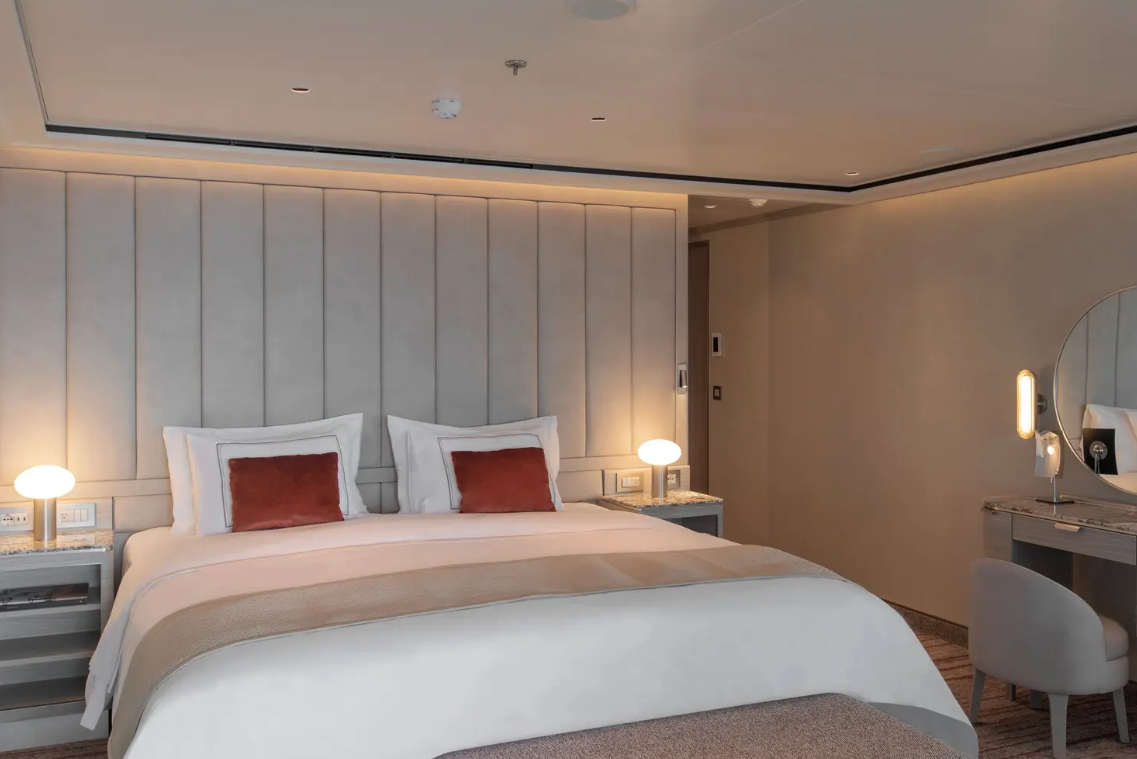
The Otium Suite is one of our newest and finest suites. Located in the premium aft corner position, the Otium Suite has a total size of 123 m2 (1,324 sq. ft.), including a 40 m2 (431 sq. ft.) balcony, which comes complete with a whirlpool. Features include a spacious living room area, a luxurious walk-in closet, a separate large bedroom, plus a bathroom with a whirlpool and walk-in shower. The crowning glory of the Otium Suite however must surely be its unprecedented 270 degree view, giving you some of the best views of your destination possible.
One bedroom: 123 sq.m. including veranda
Images are intended as a general reference. Features, materials, finishes and layout may be different than shown.
Please note the 3rd guest will sleep on a comfortable sofa bed in the reception area of suites that have 3rd berth capacity.
Essentials
- Deck(s): 6, 7
- Section: Aft
Characteristics
- Veranda
- Separate dining area
- Living room with sitting area
- Large vanity
- Separate shower
- Whirlpool bath
- Walk-in wardrobe with personal safe
Furniture
- King size bed
- Writing desk
- Vanity table
- Luxury bed mattresses (Custom made)
Media & Communication
- Unlimited Premium Wi-Fi
- 2 large flat screen TVs with Interactive Media Library
- Sound system with bluetooth connectivity
- Direct dial telephone
- Wall mounted USB-C mobile device chargers
- Dual voltage 110/220 outlets
Onboard Services
- Butler service
- Complimentary laundry, pressing & wet cleaning
- Daily canapé service, Welcome chocolate, Welcome fruit stand
- Dinner at the officer’s table
- Dinner for two in La Dame, one evening per voyage,
- Two hours of worldwide phone use, per voyage segment
- Priority check-in on embarkation day with early suite access
- Champagne on arrival
Amenities
- Espresso machine
- Pillow menu
- Refrigerator and bar setup stocked with your preferences
- Plush bathrobe
- Luxury bath amenities
- Umbrella
- Slippers
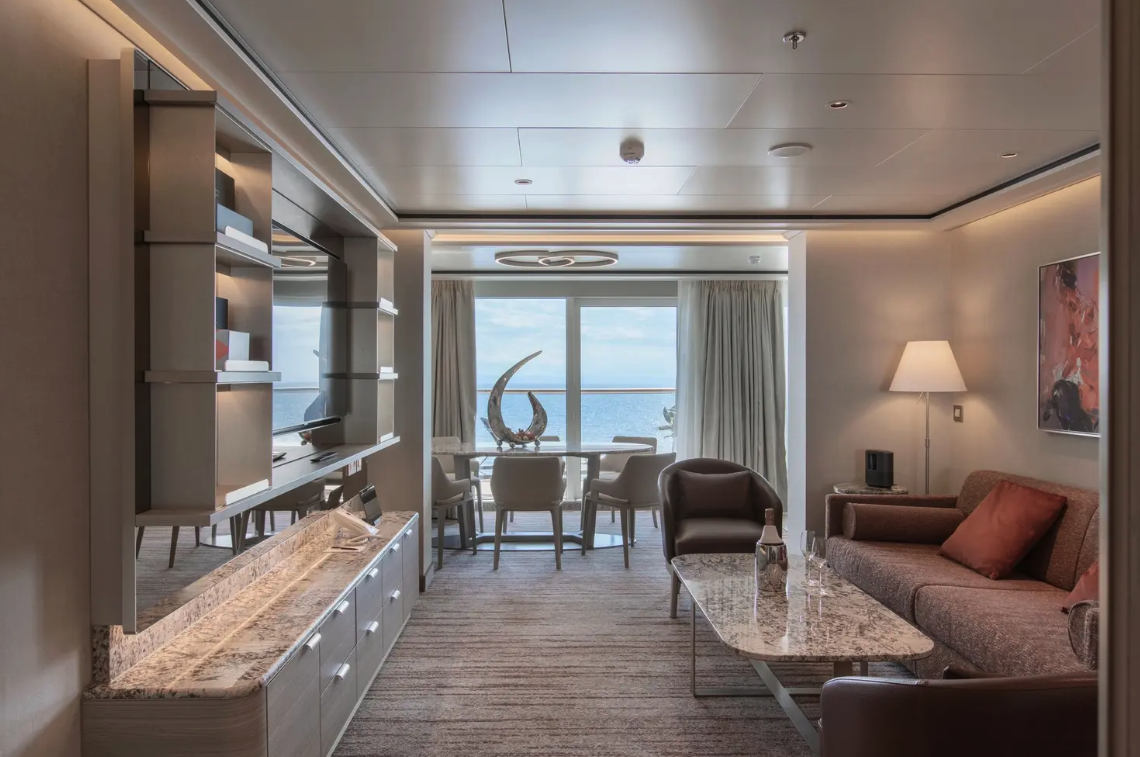
The eponymous Owner’s Suite is a Venetian Society favourite. So, why not travel in this stylish suite and get a taste of the ultimate in luxury lifestyle. The suite’s total size is a huge 98 m2 or 1055 sq. ft., which includes 16 m2 (172 sq. ft.) of balcony making for comfortable outdoor living. The favourite mid ship position gives incredible views from both the dining area and bedroom. A luxurious bathroom with double vanity, plus a whirlpool and walk-in shower, bidet, lavatory and guest restroom perfect the in-suite experience.
One bedroom: 98 sq.m. including veranda
Two bedroom: 131 sq.m. including veranda
Images are intended as a general reference. Features, materials, finishes and layout may be different than shown.
Please note the 3rd guest will sleep on a comfortable sofa bed in the reception area of suites that have 3rd berth capacity.
Essentials
- Deck(s): 8
- Section: Mid-Ship
Characteristics
- Veranda
- Separate dining area
- Living room with sitting area
- Large vanity
- Separate shower
- Whirlpool bath
- Walk-in wardrobe with personal safe
Furniture
- King size bed
- Writing desk
- Vanity table
- Luxury bed mattresses (Custom made)
Media & Communication
- Unlimited Premium Wi-Fi
- 2 large flat screen TVs with Interactive Media Library
- Sound system with bluetooth connectivity
- Direct dial telephone
- Wall mounted USB-C mobile device chargers
- Dual voltage 110/220 outlets
Onboard Services
- Butler service
- Complimentary laundry, pressing & wet cleaning
- Daily canapé service, Welcome chocolate, Welcome fruit stand
- Dinner at the officer’s table
- Dinner for two in La Dame, one evening per voyage,
- Two hours of worldwide phone use, per voyage segment
- Priority check-in on embarkation day with early suite access
- Champagne on arrival
Amenities
- Espresso machine
- Pillow menu
- Refrigerator and bar setup stocked with your preferences
- Plush bathrobe
- Luxury bath amenities
- Umbrella
- Slippers
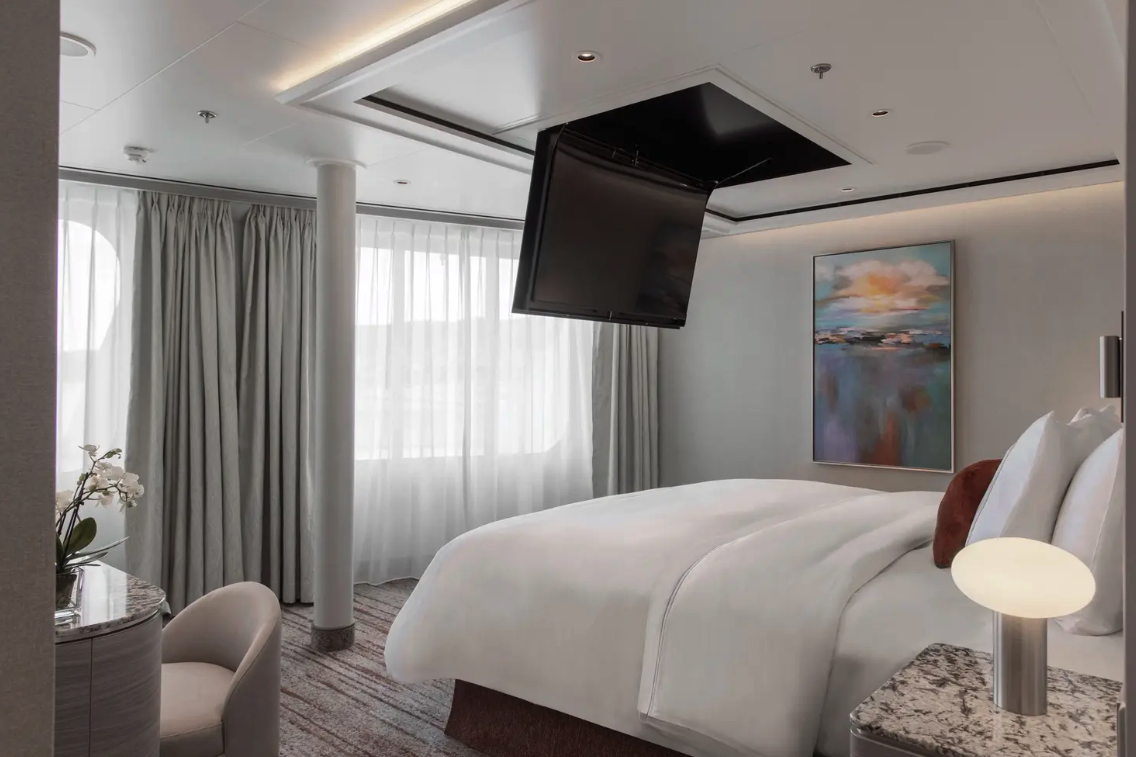
If you have ever wanted to indulge in one of our epitomes of ultra-luxury cruising, then the Grand Suite is perhaps the answer. Situated at the front of the ship, the Grand Suite offers sophistication and style for serious travellers. Thanks to an innovative design, the Grand Suite is one of the most luxurious and spacious suites aboard Silver Nova, offering sweeping sea to sky views on your destination from all living areas. A luxurious bathroom with double vanity, whirlpool and walk-in shower, plus a guest restroom complete.
One bedroom: 85 sq.m. including veranda
Two bedroom: 118 sq.m. including veranda
Images are intended as a general reference. Features, materials, finishes and layout may be different than shown.
Please note the 3rd guest will sleep on a comfortable sofa bed in the reception area of suites that have 3rd berth capacity.
Essentials
- Deck(s): 7
- Section: Forward
Characteristics
- Veranda
- Separate dining area
- Living room with sitting area
- Large vanity
- Separate shower
- Whirlpool bath
- Walk-in wardrobe with personal safe
Furniture
- King size bed
- Writing desk
- Vanity table
- Luxury bed mattresses (Custom made)
Media & Communication
- Unlimited Premium Wi-Fi
- 2 large flat screen TVs with Interactive Media Library
- Sound system with bluetooth connectivity
- Direct dial telephone
- Wall mounted USB-C mobile device chargers
- Dual voltage 110/220 outlets
Onboard Services
- Butler service
- Complimentary laundry, pressing & wet cleaning
- Daily canapé service, Welcome chocolate, Welcome fruit stand
- Dinner at the officer’s table
- Dinner for two in La Dame, one evening per voyage,
- Two hours of worldwide phone use, per voyage segment
- Priority check-in on embarkation day with early suite access
- Champagne on arrival
Amenities
- Espresso machine
- Pillow menu
- Refrigerator and bar setup stocked with your preferences
- Plush bathrobe
- Luxury bath amenities
- Umbrella
- Slippers
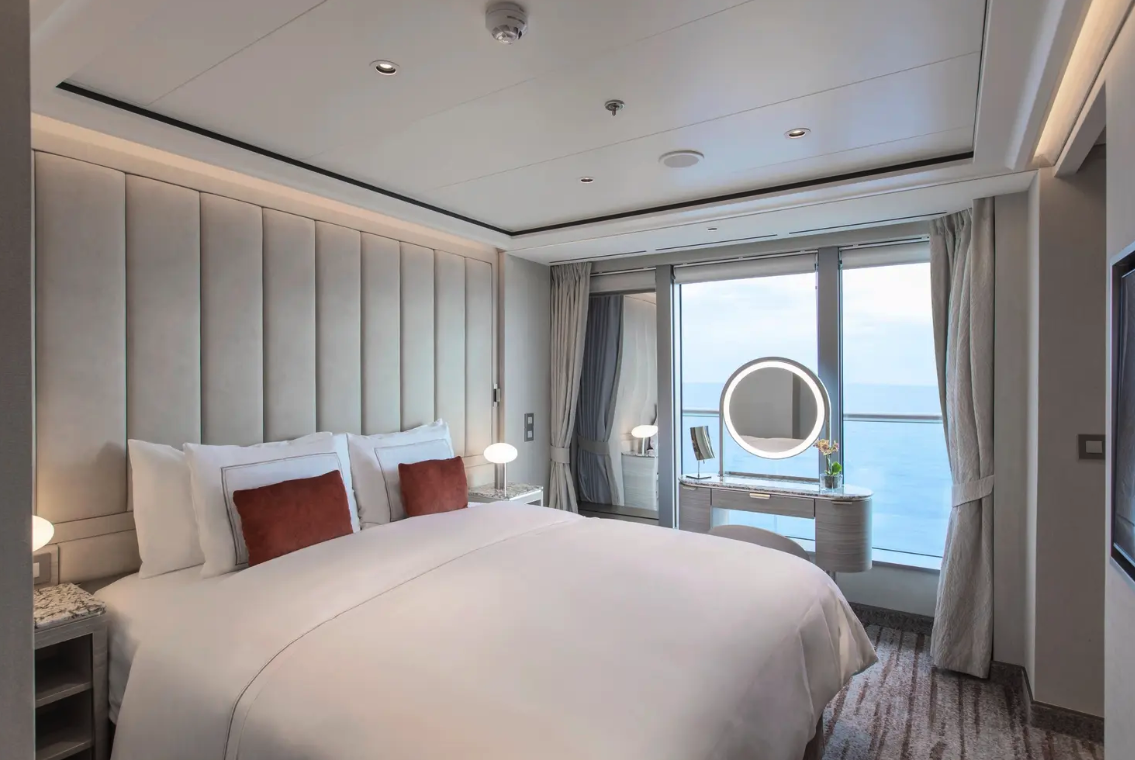
This new suite category is exclusive to Silver Nova. The Master Suite is stately, commanding and majestic and perfect for relaxing after a days’ exploring on shore. Located in the premium aft corner position, the Master Suite has a total size: 67-77 m2 (721-826 sq. ft) and includes 22-31m2 (233-330 sq. ft.) of balcony. The incredible floor-to-ceiling glazing surrounding the living room and bedroom area will offer outstanding 270° views on your destination, regardless of whether you are in the world. A sumptuous bathroom will feature sweeping views of the destination.
One bedroom: 67-77 sq.m. including veranda
Two bedroom: 100-110 sq.m. including veranda
Images are intended as a general reference. Features, materials, finishes and layout may be different than shown.
Please note the 3rd guest will sleep on a comfortable sofa bed in the reception area of suites that have 3rd berth capacity.
Essentials
- Deck(s): 6, 7, 8, 9
- Section: Aft
Characteristics
- Veranda
- Separate dining area
- Living room with sitting area
- Large vanity
- Separate shower
- Whirlpool bath
- Walk-in wardrobe with personal safe
Furniture
- King size bed
- Writing desk
- Vanity table
- Luxury bed mattresses (Custom made)
Media & Communication
- Unlimited Premium Wi-Fi
- 2 large flat screen TVs with Interactive Media Library
- Sound system with bluetooth connectivity
- Direct dial telephone
- Wall mounted USB-C mobile device chargers
- Dual voltage 110/220 outlets
Onboard Services
- Butler service
- Complimentary laundry, pressing & wet cleaning
- Daily canapé service, Welcome chocolate, Welcome fruit stand
- Dinner at the officer’s table
- Dinner for two in La Dame, one evening per voyage,
- Two hours of worldwide phone use, per voyage segment
- Priority check-in on embarkation day with early suite access
- Champagne on arrival
Amenities
- Espresso machine
- Pillow menu
- Refrigerator and bar setup stocked with your preferences
- Plush bathrobe
- Luxury bath amenities
- Umbrella
- Slippers

Another exclusivity for Silver Nova. The Signature Suite is one of our most distinctive new suites, offering unparalleled destination immersion through unobstructed views from all interior areas. The Signature Suite is one of the most spacious suites on board totalling 65 m2 or 700 sq. ft., including 16 m2 or 172 sq. ft. of balcony for superlative outdoor living. The innovative layout will feature a large dining and living room area, as well as a secluded bedroom. The large bathroom features a double vanity, whirlpool and walk-in shower and lavatory is completed by a guest restroom.
One bedroom: 65 sq.m. including veranda
Images are intended as a general reference. Features, materials, finishes and layout may be different than shown.
Please note the 3rd guest will sleep on a comfortable sofa bed in the reception area of suites that have 3rd berth capacity.
Essentials
- Deck(s): 6, 7, 8, 9
- Section: Mid-Ship
Characteristics
- Veranda
- Separate dining area
- Living room with sitting area
- Large vanity
- Separate shower
- Whirlpool bath
- Walk-in wardrobe with personal safe
Furniture
- King size bed
- Writing desk
- Vanity table
- Luxury bed mattresses (Custom made)
Media & Communication
- Unlimited Premium Wi-Fi
- 2 large flat screen TVs with Interactive Media Library
- Sound system with bluetooth connectivity
- Direct dial telephone
- Wall mounted USB-C mobile device chargers
- Dual voltage 110/220 outlets
Onboard Services
- Butler service
- Complimentary laundry, pressing & wet cleaning
- Daily canapé service, Welcome chocolate, Welcome fruit stand
- Dinner at the officer’s table
- Two hours of worldwide phone use, per voyage segment
- Priority check-in on embarkation day with early suite access
- Champagne on arrival
Amenities
- Espresso machine
- Pillow menu
- Refrigerator and bar setup stocked with your preferences
- Plush bathrobe
- Luxury bath amenities
- Umbrella
- Slippers
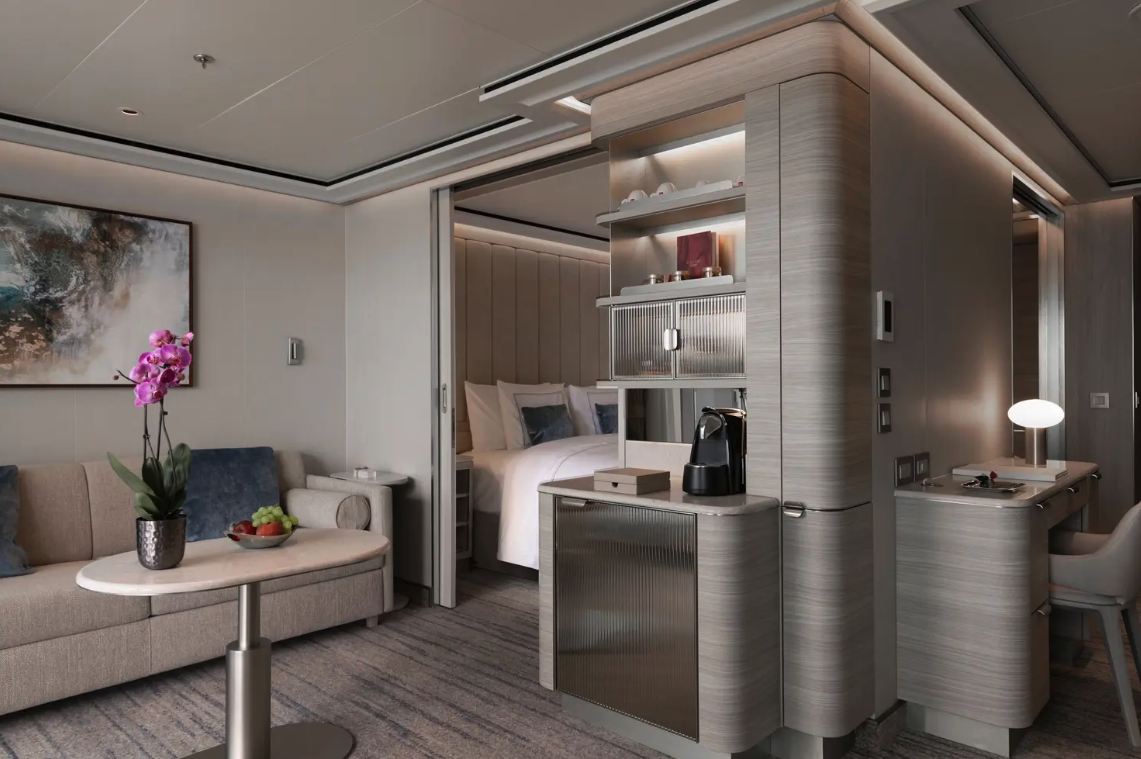
The Silver Suite is a Silversea favourite. It’s one of the Venetian Society’s favourite choices, and we can see why! The Silver Suite aboard Silver Nova offers an innovative design layout that will unlock full sea views from both the living room and bedroom, while the spacious living area allows for comfortable relaxing. A generous dining area makes cosy nights dining in veritable experiences in themselves. The suite features a generous walk-in closet as well as a bathroom with whirlpool bath, a walk-in shower, double vanity and separate lavatory.
One bedroom: 63 sq.m. including veranda
Two bedroom: 96 sq.m. including veranda
Wheelchair accessible suites: 6022, 7018
Images are intended as a general reference. Features, materials, finishes and layout may be different than shown.
Please note the 3rd guest will sleep on a comfortable sofa bed in the reception area of suites that have 3rd berth capacity.
Essentials
- Deck(s): 6, 7, 8
- Section: Mid-Ship
Characteristics
- Veranda
- Separate dining area
- Living room with sitting area
- Large vanity
- Separate shower
- Whirlpool bath (Except ADA suite (shower))
- Walk-in wardrobe with personal safe
Furniture
- King size bed
- Writing desk
- Vanity table
- Luxury bed mattresses (Custom made)
Media & Communication
- Unlimited Premium Wi-Fi
- 2 large flat screen TVs with Interactive Media Library
- Sound system with bluetooth connectivity
- Direct dial telephone
- Wall mounted USB-C mobile device chargers
- Dual voltage 110/220 outlets
Onboard Services
- Butler service
- Complimentary laundry, pressing & wet cleaning
- Daily canape service, Welcome chocolate, Welcome fruit stand
- Champagne on arrival
Amenities
- Espresso machine
- Pillow menu
- Refrigerator and bar setup stocked with your preferences
- Plush bathrobe
- Luxury bath amenities
- Umbrella
- Hair Dryer
- Slippers

Silver Nova’s Junior Grand Suite is a comfortably sized home away from home. Spaciously proportioned at 54-58 m2 or 581-624 sq. ft, including 6 m2 or 64 sq. ft of balcony, the Junior Grand builds on the success of the Grand Suite. It has inherited the best features of the Grand Suite by being positioned in the top bow position, offering spectacular views of the destination. The interior layout features a spacious living and dining area, as well as a secluded bedroom. The large bathroom features a double vanity, whirlpool and walk-in shower.
One bedroom: 54-58 sq.m. including veranda
Two bedroom: 87-91 sq.m. including veranda
Images are intended as a general reference. Features, materials, finishes and layout may be different than shown.
Please note the 3rd guest will sleep on a comfortable sofa bed in the reception area of suites that have 3rd berth capacity.
Essentials
- Deck(s): 6, 9
- Section: Forward
Characteristics
- Veranda
- Separate dining area
- Living room with sitting area
- Large vanity
- Separate shower
- Whirlpool bath
- Walk-in wardrobe with personal safe
Furniture
- King size bed
- Writing desk
- Vanity table
- Luxury bed mattresses (Custom made)
Media & Communication
- Unlimited Premium Wi-Fi
- 2 large flat screen TVs with Interactive Media Library
- Sound system with bluetooth connectivity
- Direct dial telephone
- Wall mounted USB-C mobile device chargers
- Dual voltage 110/220 outlets
Onboard Services
- Butler service
- Complimentary laundry, pressing & wet cleaning
- Daily canapé service, Welcome chocolate, Welcome fruit stand
- Champagne on arrival
Amenities
- Espresso machine
- Pillow menu
- Refrigerator and bar setup stocked with your preferences
- Plush bathrobe
- Luxury bath amenities
- Umbrella
- Slippers
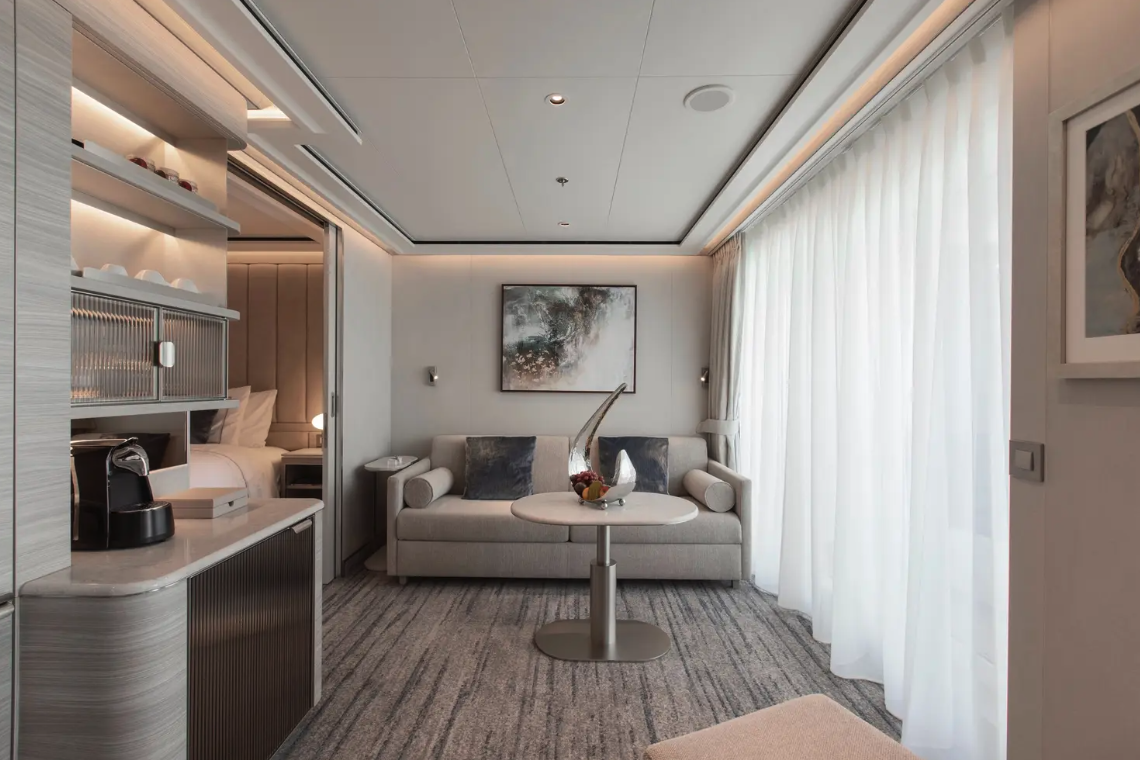
With features similar to our best-selling Medallion Suite, the Premium Medallion has an optimal placement at the aft. The Medallion Suite design builds on the phenomenal success of our iconic Veranda suite, while offering the comfort of a generous interior and balcony (49 m2/527 sq. ft. and 8 m2/86 sq. ft respectively). Additionally, the suite features a large bathroom with a double vanity, a spacious bathtub and separate shower, as well as a secluded bedroom area with king-size bed.
One bedroom: 49 sq.m. including veranda
Images are intended as a general reference. Features, materials, finishes and layout may be different than shown.
Please note the 3rd guest will sleep on a comfortable sofa bed in the reception area of suites that have 3rd berth capacity.
Essentials
- Deck(s): 6, 7, 8, 9
- Section: Aft, Mid-Ship
Characteristics
- Veranda
- Living room with sitting area
- Large vanity
- Separate shower
- Full-size bath
- Walk-in wardrobe with personal safe
Furniture
- King size bed
- Writing desk
- Vanity table
- Luxury bed mattresses (Custom made)
Media & Communication
- Unlimited Premium Wi-Fi
- 2 large flat screen TVs with Interactive Media Library
- Sound system with bluetooth connectivity
- Direct dial telephone
- Wall mounted USB-C mobile device chargers
- Dual voltage 110/220 outlets
Onboard Services
- Butler service
- Complimentary laundry, pressing & wet cleaning
- Daily canapé service, Welcome chocolate, Welcome fruit stand
- Champagne on arrival
Amenities
- Espresso machine
- Pillow menu
- Refrigerator and bar setup stocked with your preferences
- Plush bathrobe
- Luxury bath amenities
- Umbrella
- Slippers
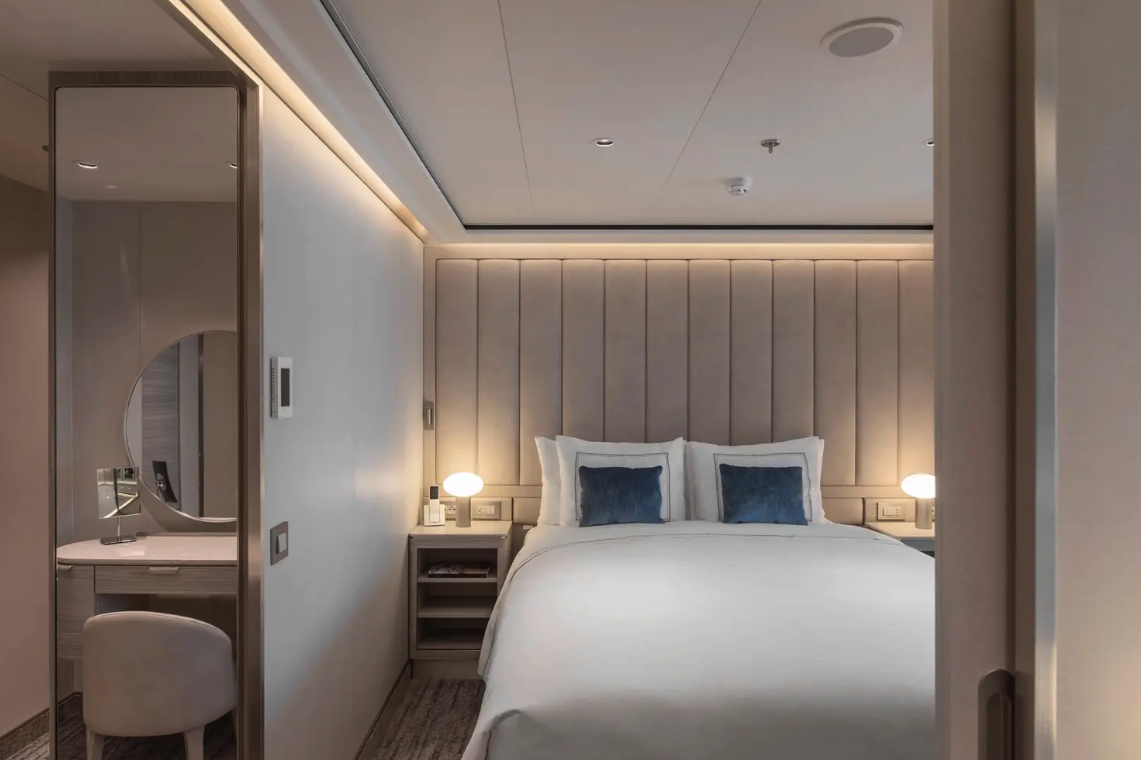
A mark of distinction, the Medallion Suite boasts a sumptuous and spacious living area, complete with rich textures and panoramic views from your large private veranda (8 m2 or 86 sq. ft.) Nestle up under plush bed linens for one of the best night’s sleep of your life, or rejuvenate after a busy day of exploring onshore in the cosy indoor sitting area (49 m2 or 527 sq. ft.) The large bathroom with double vanity, spacious bathtub and shower is the perfect place to soak the day away. Relax with ease in the Medallion Suite, as the grandeurs of this stateroom surround you with distinguished luxury.
One bedroom: 527 ft² / 49 m² including veranda
Images are intended as a general reference. Features, materials, finishes and layout may be different than shown.
Please note the 3rd guest will sleep on a comfortable sofa bed in the reception area of suites that have 3rd berth capacity.
Essentials
- Deck(s): 6, 7, 8, 9
- Section: Aft, Mid-Ship
Characteristics
- Veranda
- Living room with sitting area
- Large vanity
- Separate shower
- Full-size bath
- Walk-in wardrobe with personal safe
Furniture
- King size bed
- Writing desk
- Vanity table
- Luxury bed mattresses (Custom made)
Media & Communication
- Unlimited Premium Wi-Fi
- 2 large flat screen TVs with Interactive Media Library
- Sound system with bluetooth connectivity
- Direct dial telephone
- Wall mounted USB-C mobile device chargers
- Dual voltage 110/220 outlets
Onboard Services
- Butler service
- Complimentary laundry, pressing & wet cleaning
- Daily canapé service, Welcome chocolate, Welcome fruit stand
- Champagne on arrival
Amenities
- Espresso machine
- Pillow menu
- Refrigerator and bar setup stocked with your preferences
- Plush bathrobe
- Luxury bath amenities
- Umbrella
- Slippers
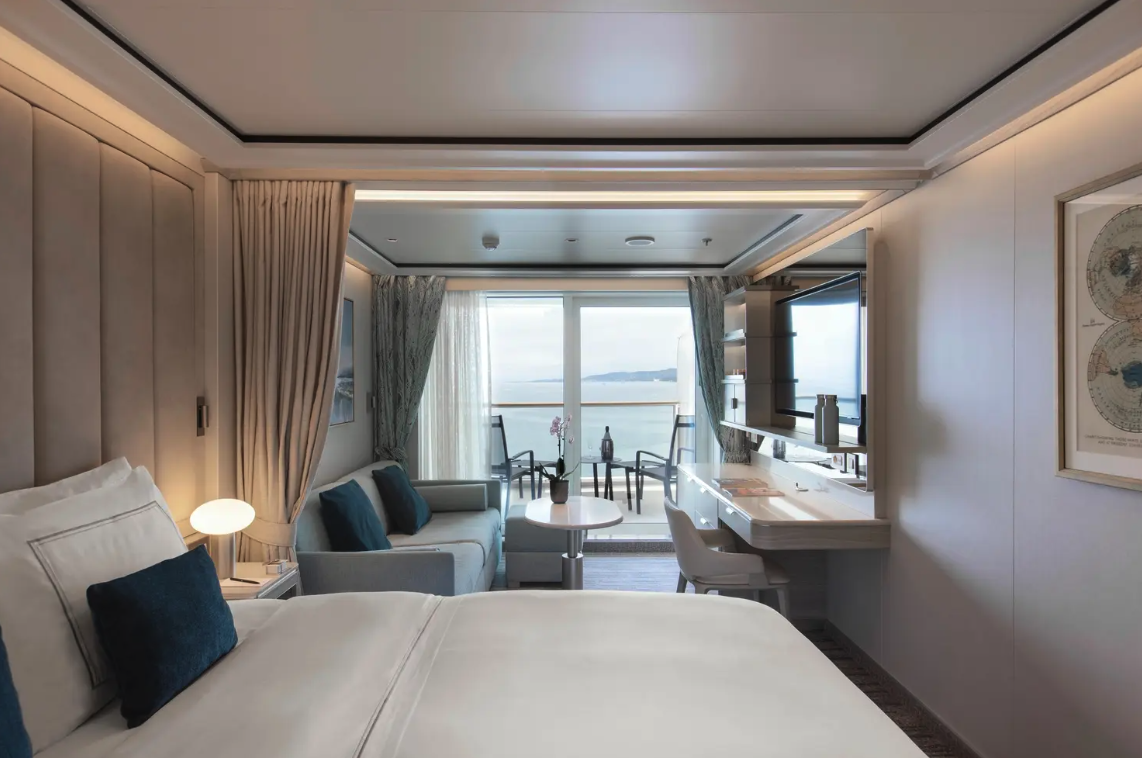
A Silversea signature, the Veranda Suite offers elegant décor, a stunning marbled bathroom with a luxurious double vanity and sumptuous walk-in shower or large bathtub. Located now in the top aft location, the Premium Veranda will offer a comfortable interior. Additionally, an ample sitting area provides a generous expanse of interior comforts. Four suites (one on each deck) will offer spacious interiors adapted for guests with disabilities which will be located in the ideal mid-ship position. A new iteration of our iconic and perfect suite configuration.
One bedroom: 33 sq.m. including veranda
Wheelchair accessible suites: 6045, 7037, 8031, 9041
Images are intended as a general reference. Features, materials, finishes and layout may be different than shown.
Please note the 3rd guest will sleep on a comfortable sofa bed in the reception area of suites that have 3rd berth capacity.
Essentials
- Deck(s): 6, 7, 8, 9
- Section: Aft, Mid-Ship
Characteristics
- Veranda
- Sitting area
- Large vanity
- Separate shower
- Some with full-size bath (Bath & shower combination (indicated with drop sign on deck plan))
- Walk-in wardrobe with personal safe
Furniture
- Queen size bed
- Writing desk
- Vanity table
- Luxury bed mattresses (Custom made)
Media & Communication
- Unlimited Standard Wi-Fi
- 1 large flat screen TV with Interactive Media Library
- Direct dial telephone
- Wall mounted USB-C mobile device chargers
- Dual voltage 110/220 outlets
Onboard Services
- Butler service
- Champagne on arrival
Amenities
- Pillow menu
- Refrigerator and bar setup stocked with your preferences
- Plush bathrobe
- Luxury bath amenities
- Umbrella
- Slippers
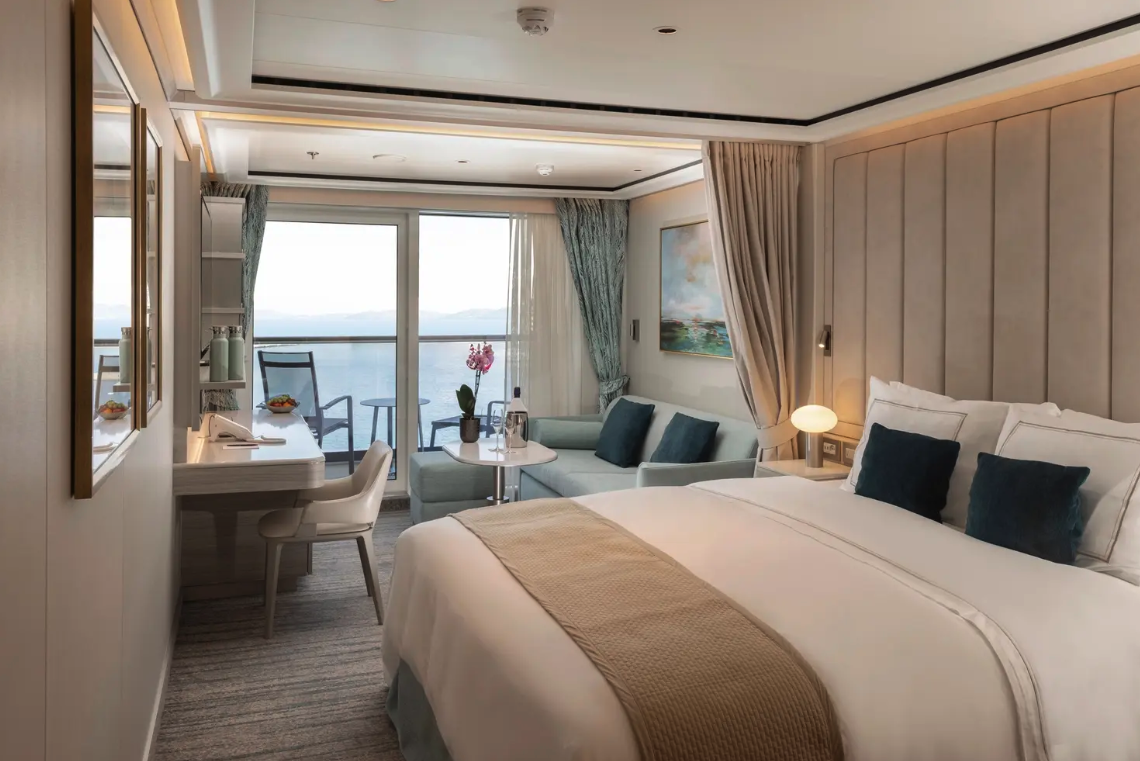
Whether you are preparing for a dynamic day on shore, primping for a romantic dinner on board, or settling down for a quiet evening in-suite, you will be enveloped by the Deluxe Veranda Suite’s warm touches. Located in the ideal mid-ship position, the Deluxe Veranda Suite offers a comfortable 33 m2 of interior luxury. But perhaps this suite’s finest asset lies just outside, as floor-to-ceiling glass doors open onto a furnished private teak 5 m2 veranda offering sweeping views of your destination.
One bedroom: 33 sq.m. including veranda
Two bedroom: 33 m² including veranda
Images are intended as a general reference. Features, materials, finishes and layout may be different than shown.
Please note the 3rd guest will sleep on a comfortable sofa bed in the reception area of suites that have 3rd berth capacity.
Essentials
- Deck(s): 6, 7, 8, 9
- Section: Aft, Mid-Ship
Characteristics
- Veranda
- Sitting area
- Large vanity
- Separate shower
- Some with full-size bath (Bath & shower combination (indicated with drop sign on deck plan))
- Walk-in wardrobe with personal safe
Furniture
- Queen size bed
- Writing desk
- Vanity table
- Luxury bed mattresses (Custom made)
Media & Communication
- Unlimited Standard Wi-Fi
- 1 large flat screen TV with Interactive Media Library
- Direct dial telephone
- Wall mounted USB-C mobile device chargers
- Dual voltage 110/220 outlets
Onboard Services
- Butler service
- Champagne on arrival
Amenities
- Pillow menu
- Refrigerator and bar setup stocked with your preferences
- Plush bathrobe
- Luxury bath amenities
- Umbrella
- Slippers

Well situated at the front and back of the ship, the 28 m2 interior of the Veranda Suite is only the beginning. The 5m2 teak balcony makes each spectacular sunset feel like it is yours alone. From beautiful bed linens to sumptuous furniture, our Superior Veranda suites are luxurious inside and out! Whether enjoying some down time with the state of the art entertainment system or taking in dinner in-suite, the Superior Veranda is the cosiest home away from home on the high seas.
One bedroom: 33 sq.m. including veranda
Images are intended as a general reference. Features, materials, finishes and layout may be different than shown.
Please note the 3rd guest will sleep on a comfortable sofa bed in the reception area of suites that have 3rd berth capacity.
Essentials
- Deck(s): 6, 7, 8, 9
- Section: Aft, Mid-Ship
Characteristics
- Veranda
- Sitting area
- Large vanity
- Separate shower
- Some with full-size bath (Bath & shower combination (indicated with drop sign on deck plan))
- Walk-in wardrobe with personal safe
Furniture
- Queen size bed
- Writing desk
- Vanity table
- Luxury bed mattresses (Custom made)
Media & Communication
- Unlimited Standard Wi-Fi
- 1 large flat screen TV with Interactive Media Library
- Direct dial telephone
- Wall mounted USB-C mobile device chargers
- Dual voltage 110/220 outlets
Onboard Services
- Butler service
- Champagne on arrival
Amenities
- Pillow menu
- Refrigerator and bar setup stocked with your preferences
- Plush bathrobe
- Luxury bath amenities
- Umbrella
- Slippers
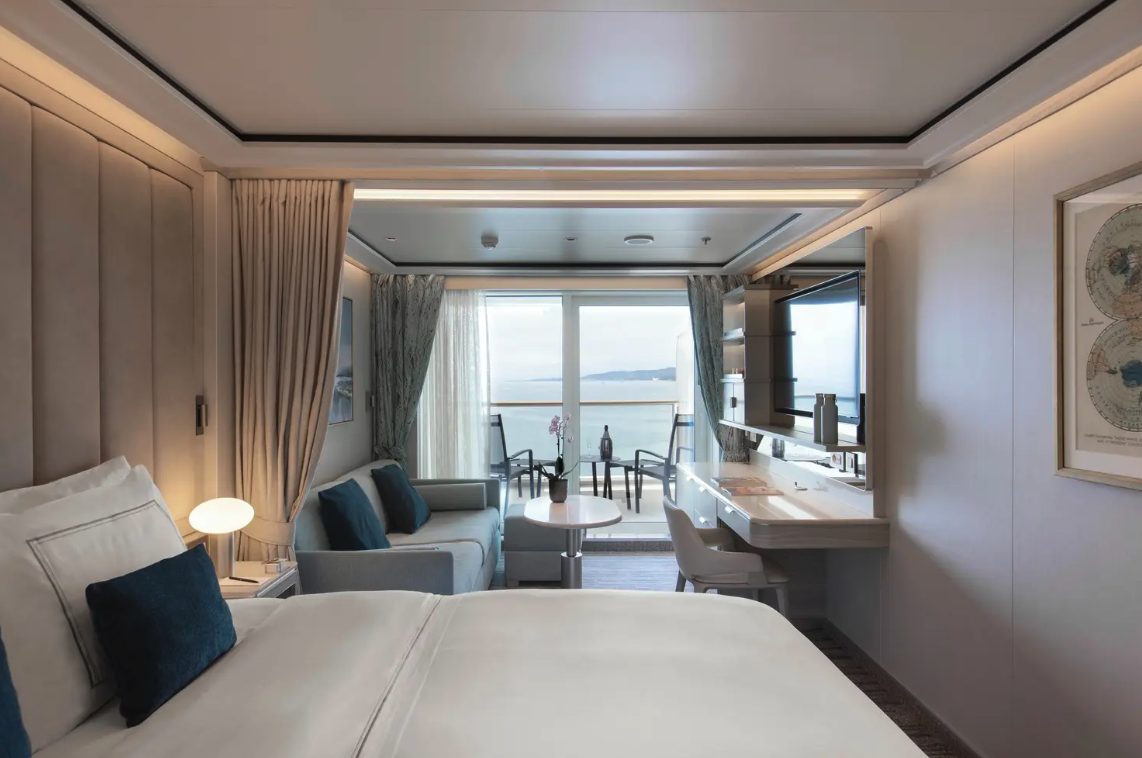
Located at the bow and aft of the ship, the Classic Veranda Suite will offer travellers a taste of our famous on board luxury. After a busy day of exploring, welcome home to the haven of the Classic Veranda Suite. With butler service, a queen size bed (which can be separated on demand) and beautiful marble bathroom, you won’t want to leave! However, the best part of our Classic Veranda suite is by far the large (5m2) private, teak veranda which offer sweeping views of the destination. Pure bliss.
One bedroom: 33 sq.m. including veranda
Images are intended as a general reference. Features, materials, finishes and layout may be different than shown.
Please note the 3rd guest will sleep on a comfortable sofa bed in the reception area of suites that have 3rd berth capacity.
Essentials
- Deck(s): 6, 7, 8, 9
- Section: Aft, Mid-Ship
Characteristics
- Veranda
- Sitting area
- Large vanity
- Separate shower
- Some with full-size bath (Bath & shower combination (indicated with drop sign on deck plan))
- Walk-in wardrobe with personal safe
Furniture
- Queen size bed
- Writing desk
- Vanity table
- Luxury bed mattresses (Custom made)
Media & Communication
- Unlimited Standard Wi-Fi
- 1 large flat screen TV with Interactive Media Library
- Direct dial telephone
- Wall mounted USB-C mobile device chargers
- Dual voltage 110/220 outlets
Onboard Services
- Butler service
- Champagne on arrival
Amenities
- Pillow menu
- Refrigerator and bar setup stocked with your preferences
- Plush bathrobe
- Luxury bath amenities
- Umbrella
- Slippers

The expansive, attractive Marquee houses two of our greatest dining successes. Thanks to Silver Nova’s groundbreaking asymmetrical design, we have been able to create an exciting new al fresco dining venue. The Marquee incorporates both The Grill and Spaccanapoli—two of Silversea’s existing signature venues, which offer guests our trademark ‘hot rocks’ culinary concept as well as what are surely the best pizzas at sea. The Marquee will welcome guests in a relaxed atmosphere, serving casual fare by day and dinner under the stars by night.
Images are intended as a general reference. Features, materials, finishes and layout may be different than shown.
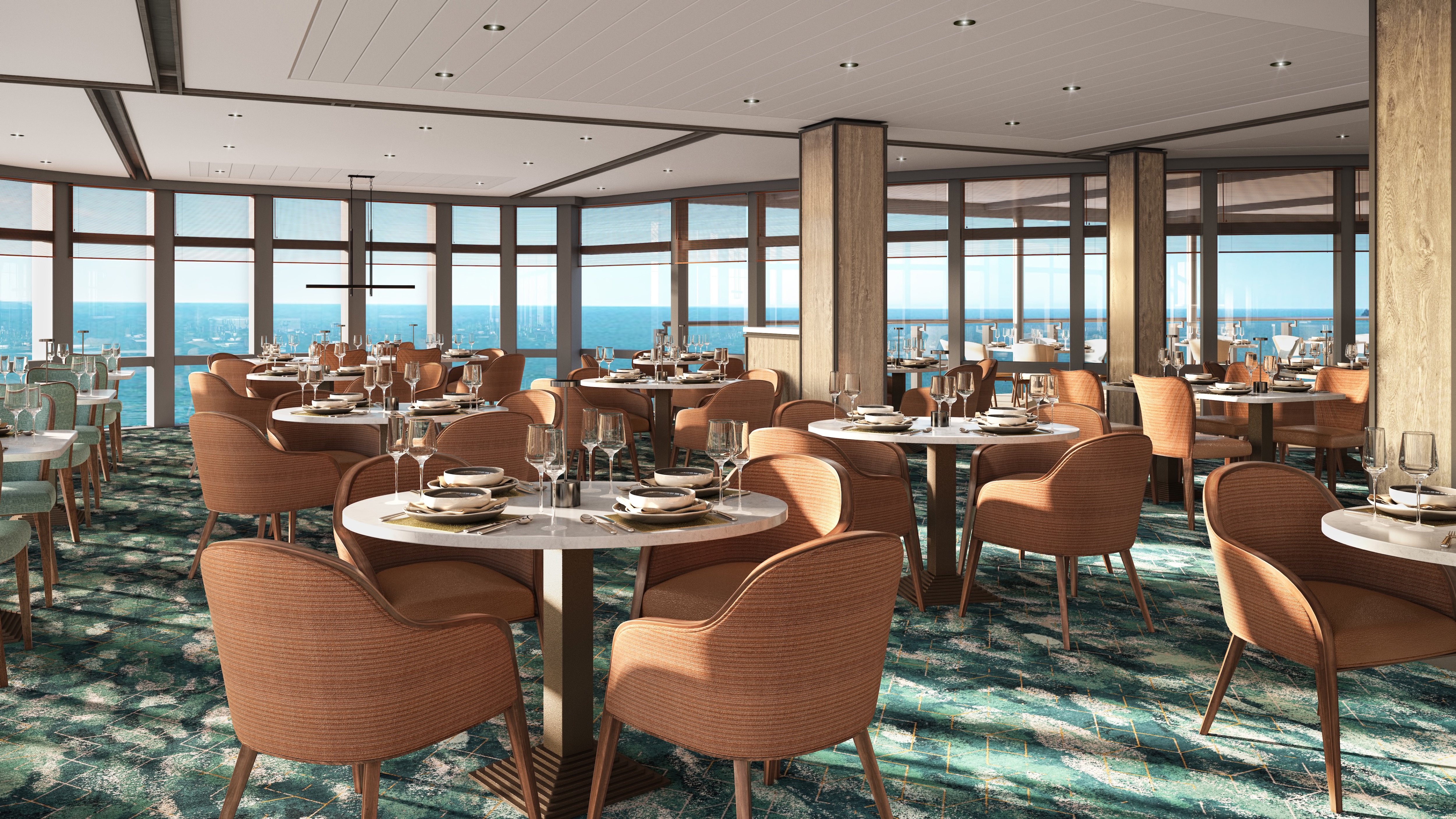
Our hallmark Italian restaurant is as varied as the food-loving country itself. La Terrazza aboard Silver Nova offers an unparalleled destination dining experience, from its expansive floor-to-ceiling windows to its large, outdoor terrace. Enjoy all the tastes of the different regions, including the best homemade pasta, fresh antipasto, bowls of steaming risotto, hearty ragu and delicious tiramisu. Be sure to try one of the bold wines from the cellar, to wash it all down.
Images are intended as a general reference. Features, materials, finishes and layout may be different than shown.
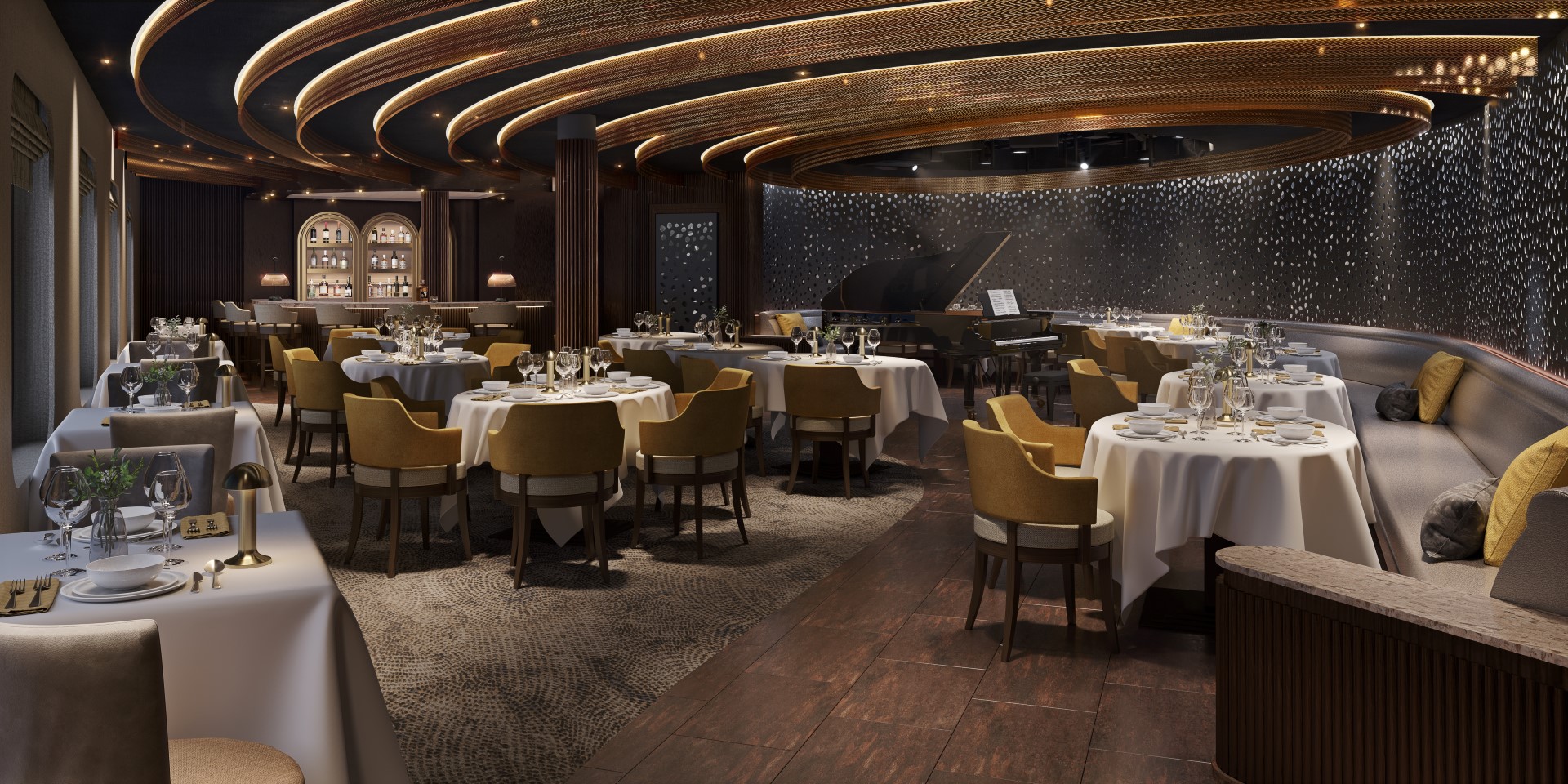
Where do you go if you want great food and a brilliant atmosphere in a relaxed and sophisticated setting? Silver Note of course! Harkening back to the old school days of dinner and dancing, this venue embodies a feeling of fun and sense of glamour that is unequalled in the industry. Jazz bands and soul singers play live as you sample delicate tapas style dishes with a gourmet twist. We guarantee a superlative night of entertainment in the gorgeously designed dinner venue.
Images are intended as a general reference. Features, materials, finishes and layout may be different than shown.
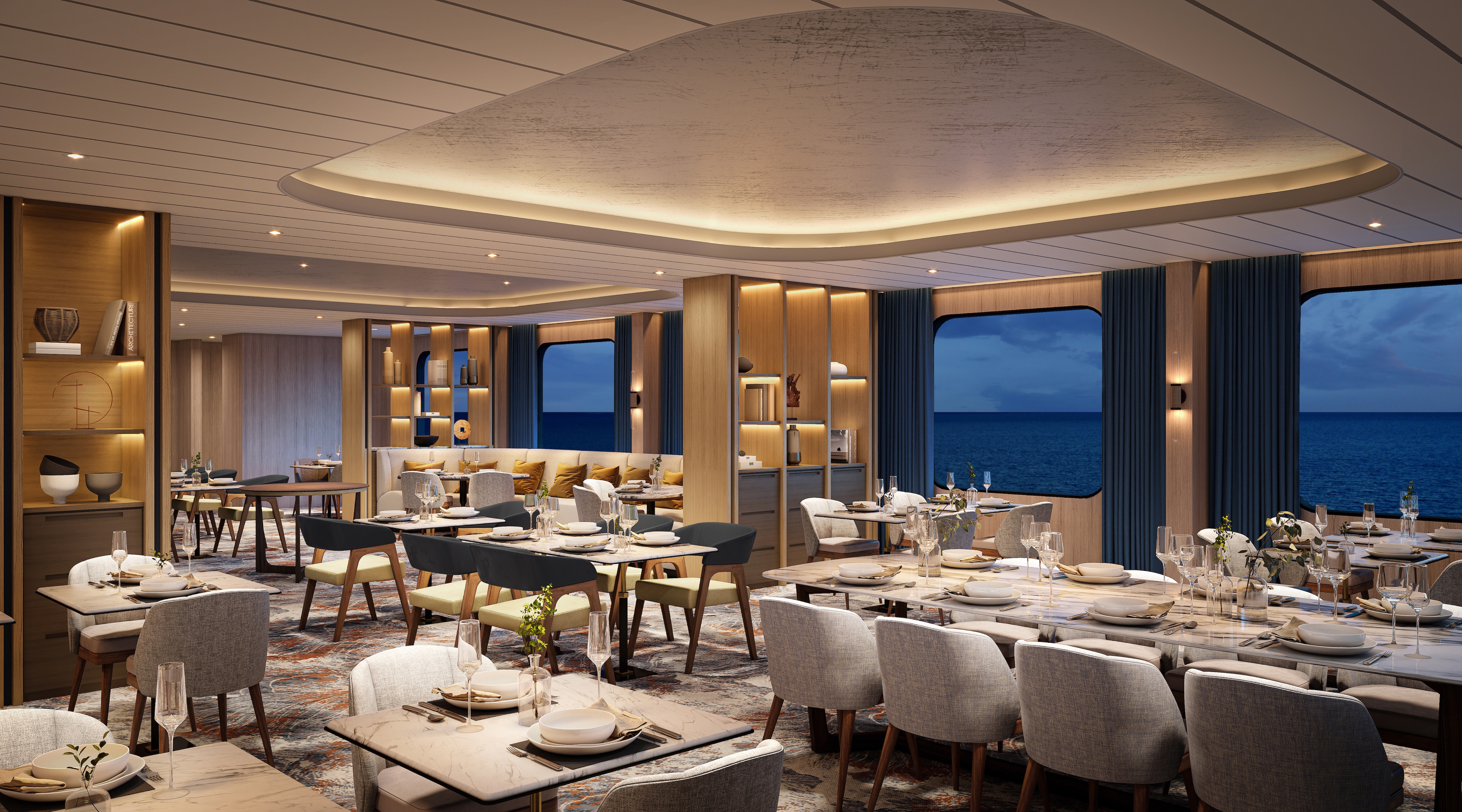
Are you hungry for something new? Eat your way through the places on your cruise in the S.A.L.T. Kitchen. Enjoy destination-inspired menus, including the Terrain menu, which offers recipes and flavours specific to the port visited, and the Voyage menu, which draws inspiration from the best flavours of the voyage. Pull up a chair and savour every taste of your cruise in a vibrant and welcoming atmosphere. S.A.L.T. Kitchen is the opportunity for all guests aboard Silver Nova to experience the very lifeblood of their destination.
Images are intended as a general reference. Features, materials, finishes and layout may be different than shown.

France’s haute cuisine is not world-famous for nothing! La Dame is a classy, contemporary, fine dining restaurant that is more beautiful and luxurious than ever. Enjoy polished French-inspired menus with deep, balanced flavours topped off by one of the best wine lists at sea, for a luxury dining experience extraordinaire! Signature Lalique crystal decor including the iconic Masque de Femme panels plus a stunning Hirondelles crystal chandelier bathe you in sophisticated, elegant décor.
Per guest reservation fee of US$60.
Images are intended as a general reference. Features, materials, finishes and layout may be different than shown.
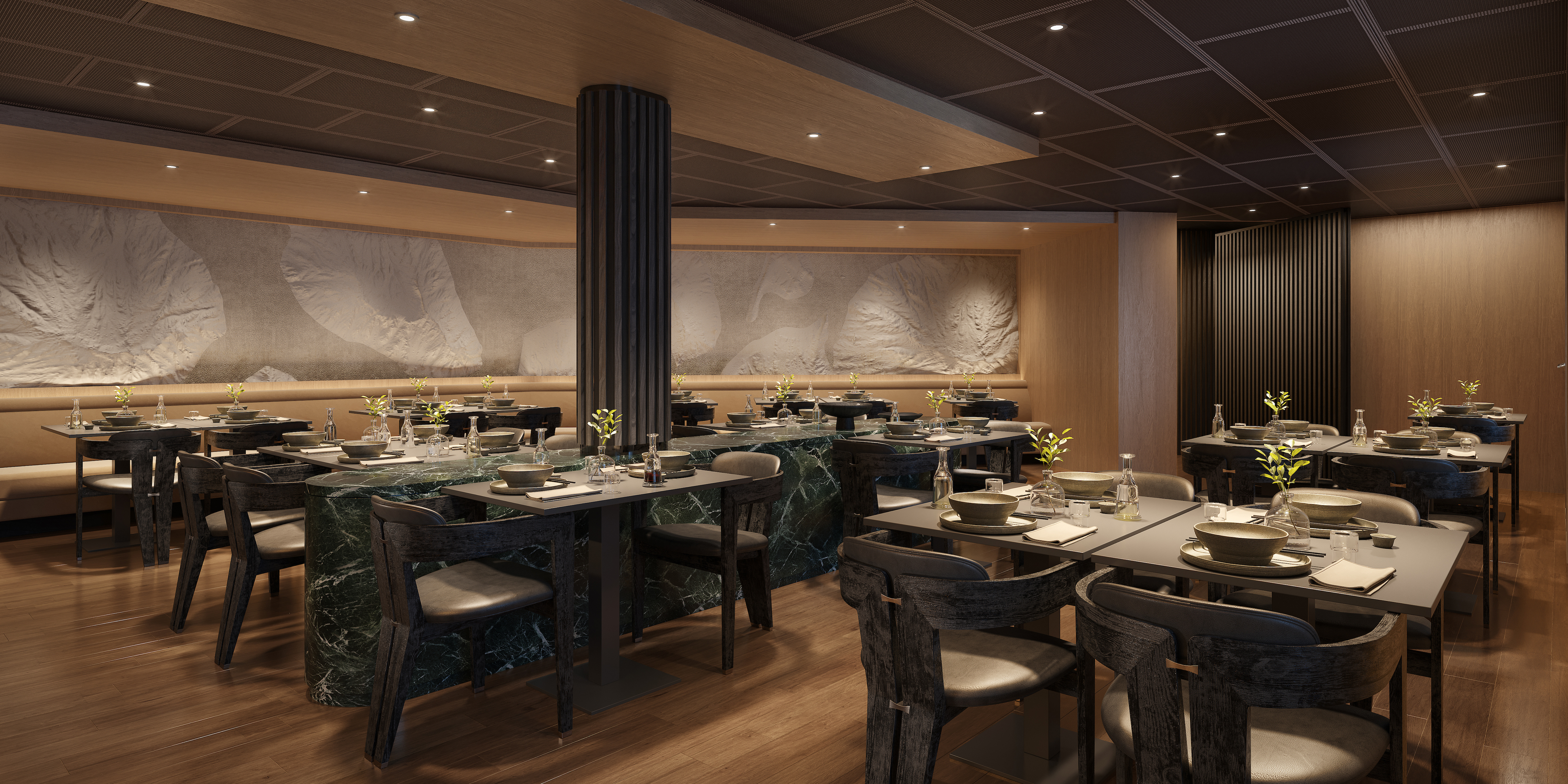
If you think Japanese food is only raw fish then think again. Certainly, we serve excellent sushi, but Kaiseki has so much more to offer. Watch the skilled chefs at work around the central teppanyaki table, soothed by the minimalist, authentic Japanese décor and calming ambience. The cuisine of the Land of the Rising Sun might be the speciality, but if you are craving Asian flavours then Kaiseki aboard Silver Nova extends its menu to include other Asian specialties such as Vietnamese, Thai, Indian, Korean and Chinese.
Per guest reservation fee of US$40.
Images are intended as a general reference. Features, materials, finishes and layout may be different than shown.

Atlantide offers guests our quintessential dining experience. Combining contemporary elegance and hallmark Silversea service, this classic restaurant offers our signature fine dining. Atlantide is one of our best-loved eateries, and on Silver Nova we have given it an updated design. Large picture windows, sophisticated lighting design, plus a warm colour spectrum give Atlantide a blend of high-end and whispered luxury. The menu prides itself on superb ingredients and sublime flavour combinations, from caviar to lobster to gorgeous, melt in the mouth deserts.
Images are intended as a general reference. Features, materials, finishes and layout may be different than shown.
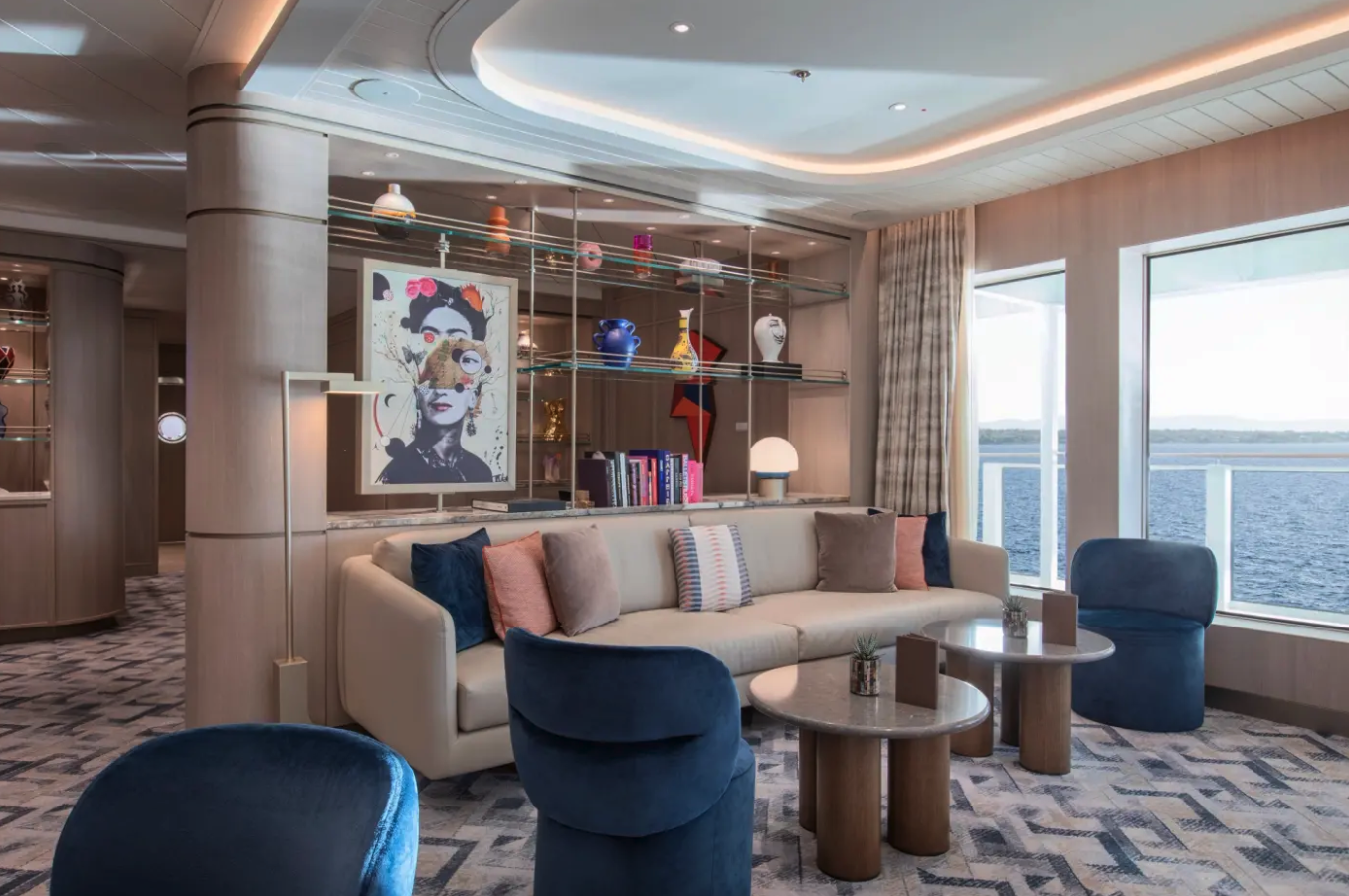
The Arts Café offers a cultural setting for eating, drinking and socialising, as well as a chance to lose yourself while reading up on all your favourite artists and art. Enjoy healthy snacks and smoothies plus hot and cold drinks, juices, pastries and sandwiches in a light and airy space. Pop in for a late breakfast or afternoon snack, along with real Italian espresso plus a great range of tea.
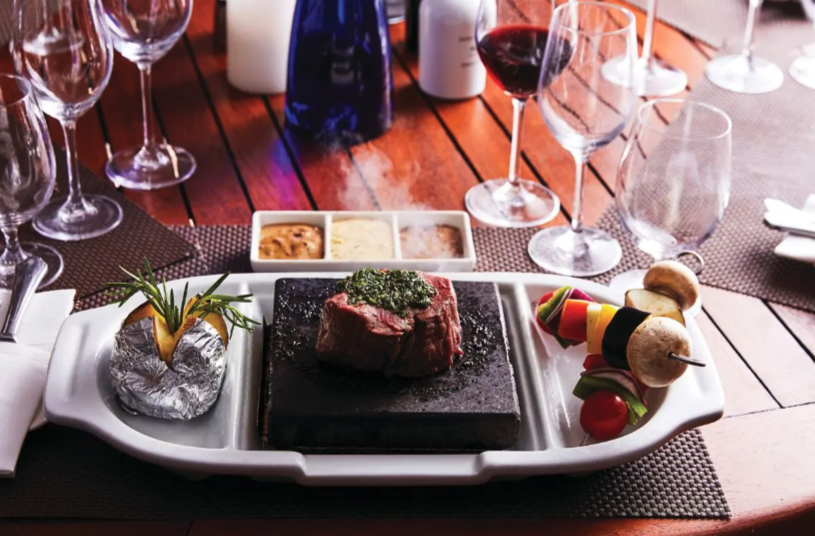
Silversea’s much-loved casual dining restaurants serves a delectable range of burgers and salads by day, and turns into our famous Hot Rocks table BBQ concept by night. Found in our brand new eating venue The Marquee, The Grill is quite simply, the best place to eat between sea and sky. If you like flavoursome meals cooked to perfection, a casual laid back atmosphere and OMG views, then The Grill is the answer to your prayers.
Images are intended as a general reference. Features, materials, finishes and layout may be different than shown.
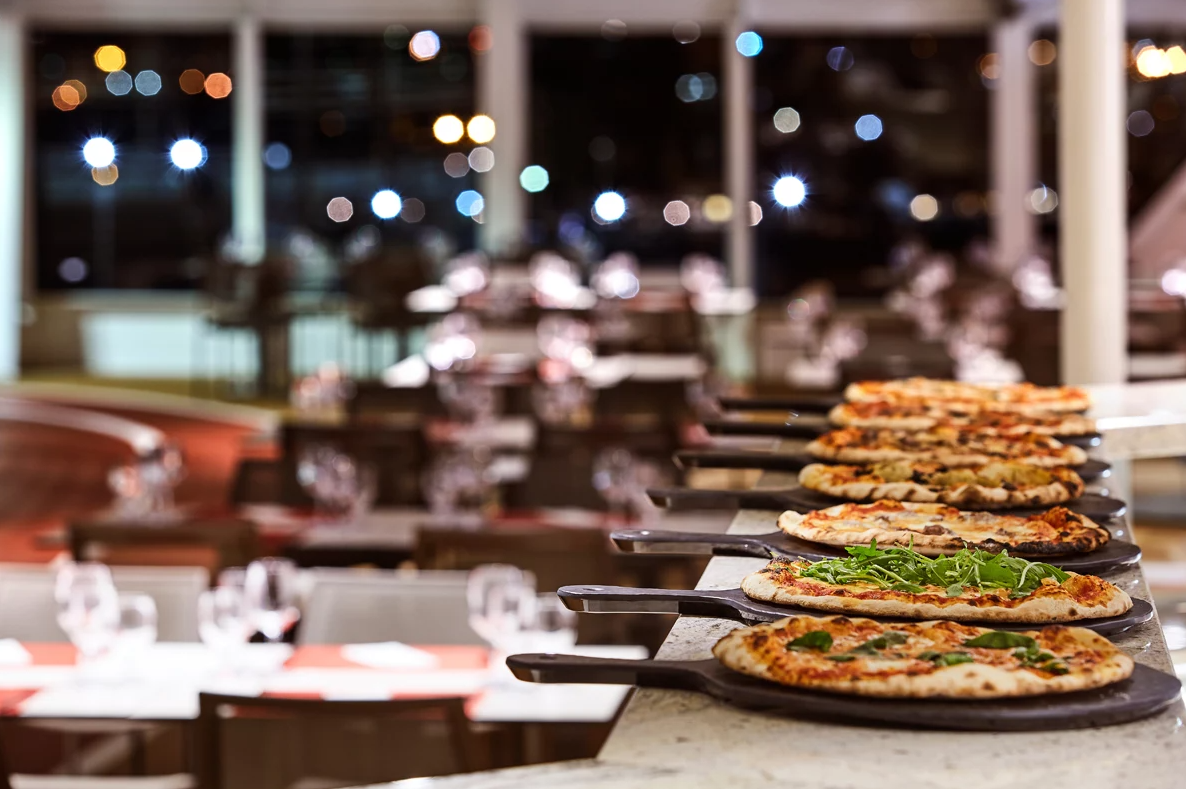
Nothing says Italy quite as well as a hot, fresh pizza. Spaccanapoli is a slice of Naples, where you’ll taste deliciously thin, freshly made pizzas, topped with creamy mozzarella and minimalist toppings. The light and airy pizzeria forms part of our new al-fresco eatery The Marquee, and is the perfect choice for diners who want to be dazzled by our talented pizzaiolos spinning the dough in the open-air kitchen. Whether you want a light lunch or to share a slice with friends over an aperitivo, it’s always the right time for Spaccanapoli.
Images are intended as a general reference. Features, materials, finishes and layout may be different than shown.
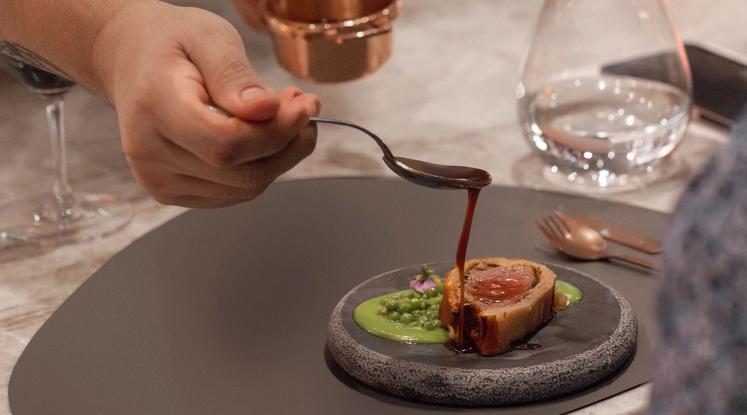
Prepare for an intimate and interactive dining experience like no other at the S.A.L.T. Chef’s Table. Indulge in a choreographed menu of small plates highlighting regional flavours and star ingredients, all accompanied by unique wines and cocktails.
Per guest reservation fee of U$180 (incl. complimentary wine & cocktail pairing). Reservations will be taken exclusively on board Silver Nova.
Images are intended as a general reference. Features, materials, finishes and layout may be different than shown.
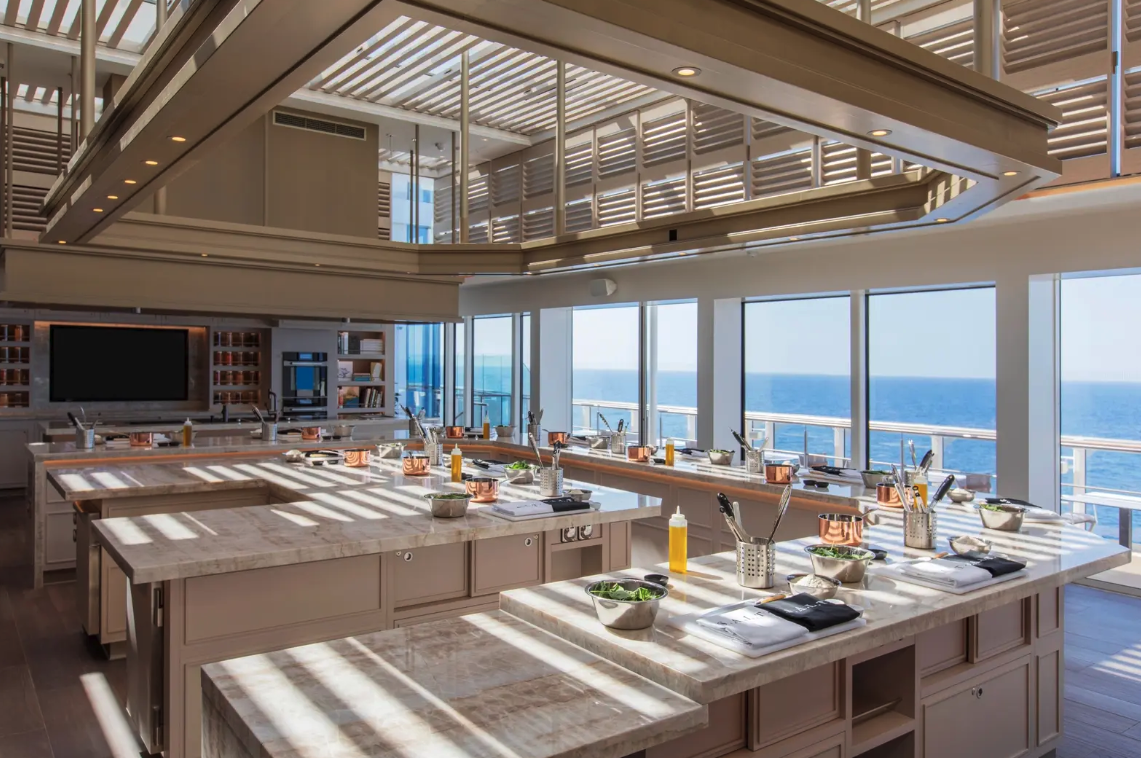
Welcome to the S.A.L.T. Lab, an interactive space where guests can deep-dive into local culinary heritage and techniques. Join our talented chefs and learn how your region’s food is central to its culture. Engage in your destination through workshops, lectures and cooking demonstrations for an authentic souvenir not available in any shop. The S.A.L.T. Lab is not just about food and flavour; it is a unique place where holistic destination immersion gives an entirely new dimension to travelling. This is where the magic happens!
Images are intended as a general reference. Features, materials, finishes and layout may be different than shown.
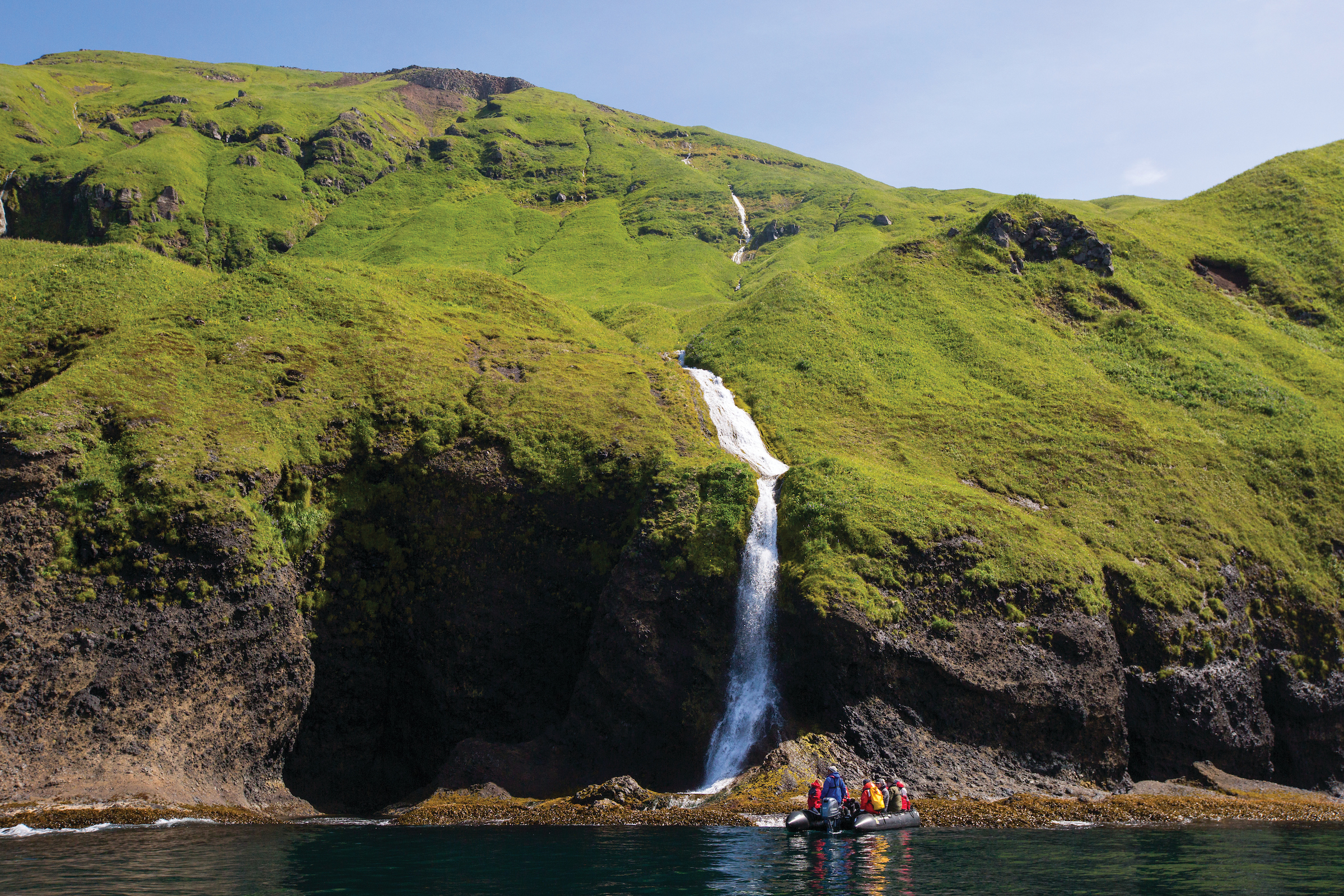
Silversea’s experienced Shore Concierge team are happy to assist, ensuring your shore- side experience is nothing less than a memory that lasts forever. Their knowledge and understanding of ports will truly add to your enjoyment and experience. Detailing history, local flavour, culture, regional customs, shopping tips and much more, they will make sure you get the best of your destination, wherever you are in the world.

Multiple days at sea mean plenty of R & R for some, but others prefer to drink in all there is to offer on land. Our Mid-Cruise Land Adventures allow you to take full advantage of your time with us without missing a single thing! These short escapades offer an array of adventures, break up your sea days and allow for deeper exploration beyond the coast.

Let Silversea customise a special event or excursion exclusively for you. Expert Shore Excursion professionals are available to assist with all your shorex questions. Make an appointment and gain insider access to knowledgeable suggestions, personalised planning and hassle-free coordination of all private, independent touring, including area highlights, flightseeing, water sports, and much more. Take advantage of this service either in advance of your voyage by email at shoreconcierge@silversea.com or on board by visiting the Silvershore® Concierge desk. Have the Silver Shore Concierge create your tailor-made tour, or be whisked away by private car for a day — the pace and agenda are up to you.
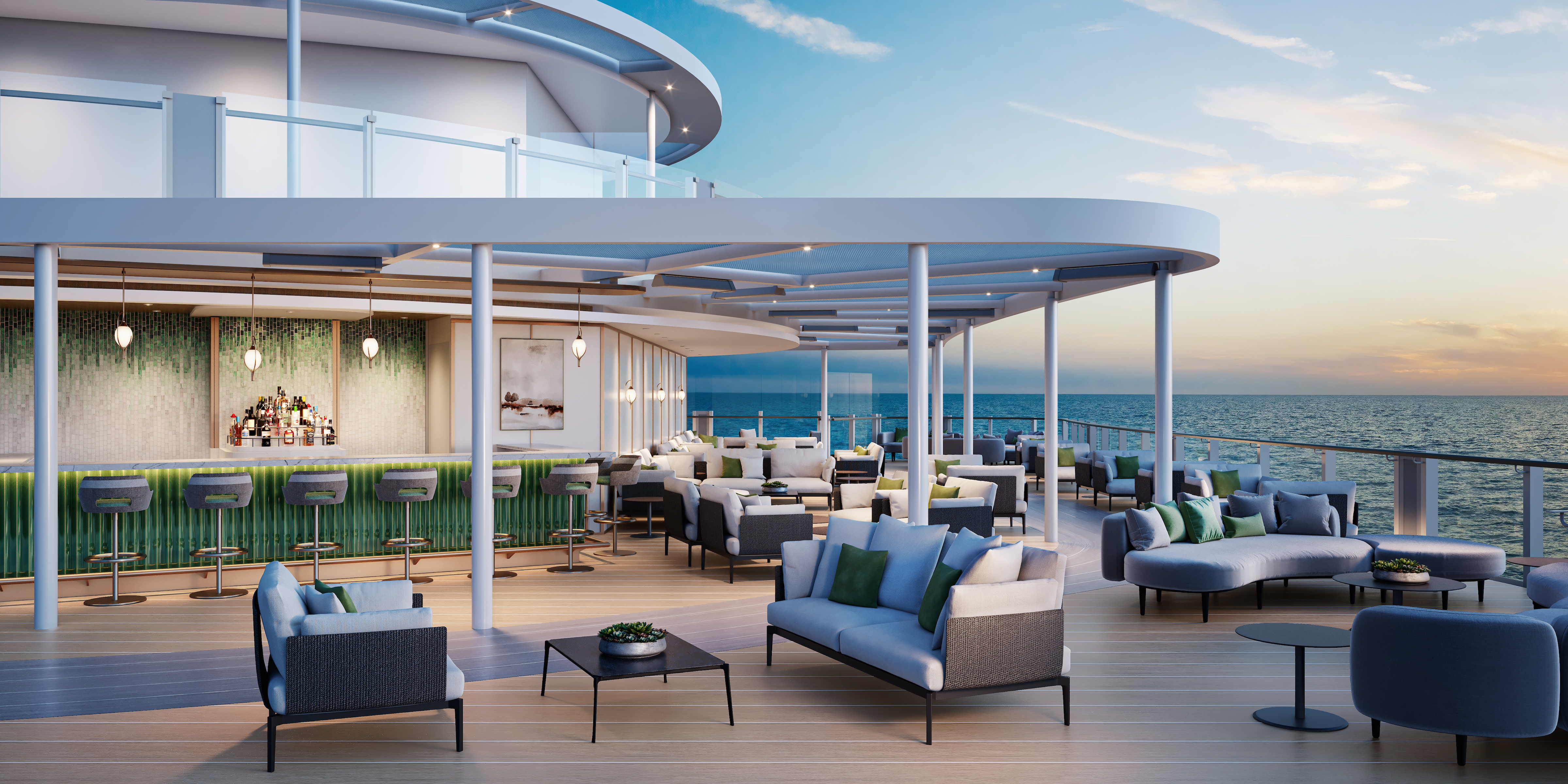
With an emphasis on the destination, panoramic views connects you with the world beyond on The Dusk Bar. This superb open-air sky bar provides plenty of space for guests to enjoy a pre or post dinner drink, while drinking in the jaw dropping 270-degree, panoramic views from the stern. The Dusk Bar’s blessed combination of idyllic atmosphere and lovely drinks will guarantee to tick your boxes time after time. Whether you’re enjoying a Spritz in South America, a cocktail in the Caribbean or a night cap in the Mediterranean, we think The Dusk Bar’s unobstructed views give you a new perspective on sunsets at sea.
Images are intended as a general reference. Features, materials, finishes and layout may be different than shown.
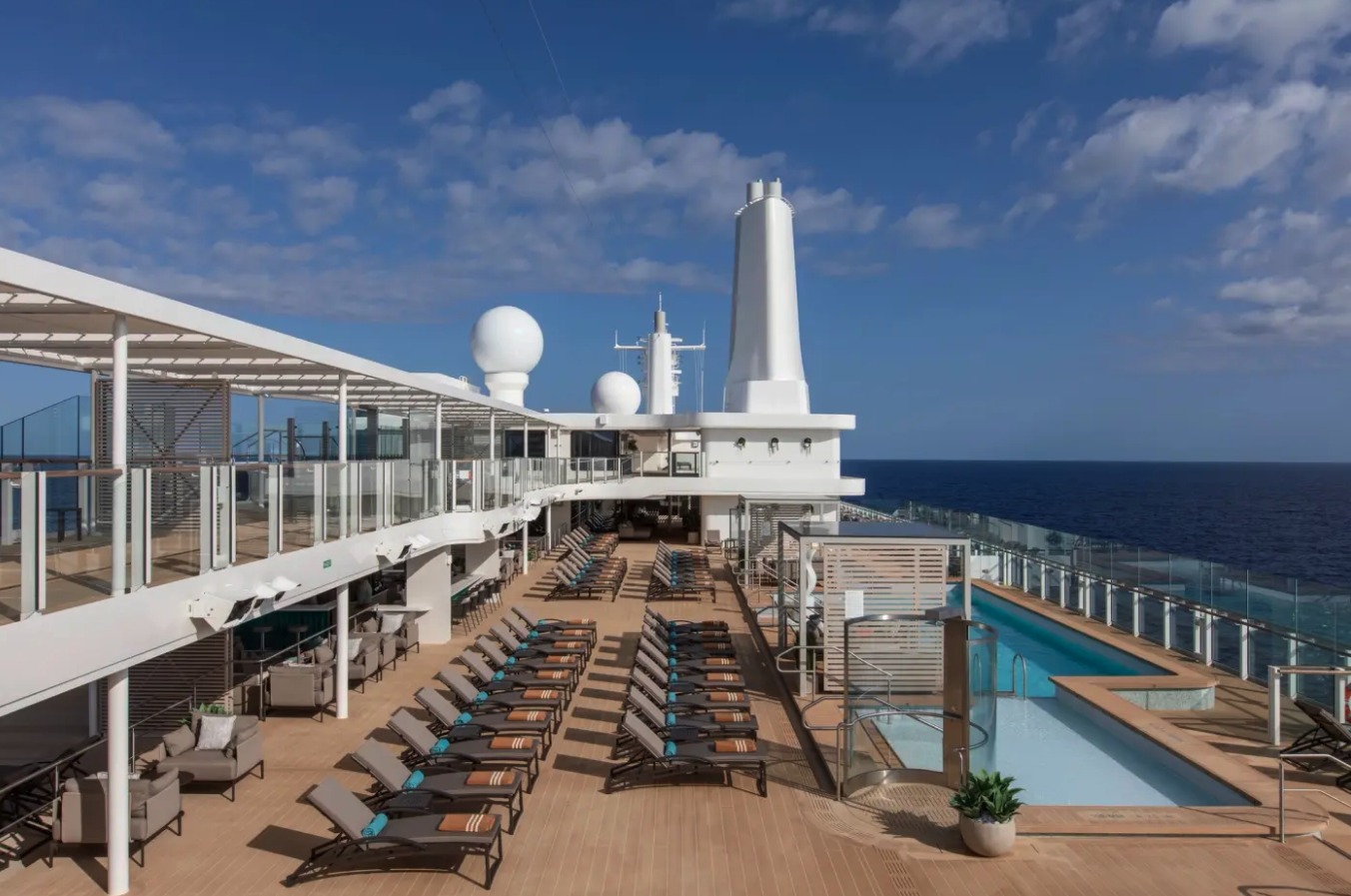
Enjoy a reimagined space where you can relax, refresh and rejuvenate on decks 10 and 11. Ample sunbeds for everyone, more space than ever before and the largest pool in the fleet – which offers exceptional 270˚ unhampered views – are just the beginning. The upper level sun deck is perfectly placed for those who want a quieter space to relax, and still enjoy those incredible, expansive views that are the hallmark of Silver Nova. But it is The Cliff Whirlpool, an infinity edge, glass fronted whirlpool, that really makes The Pool Deck something special.
Images are intended as a general reference. Features, materials, finishes and layout may be different than shown.
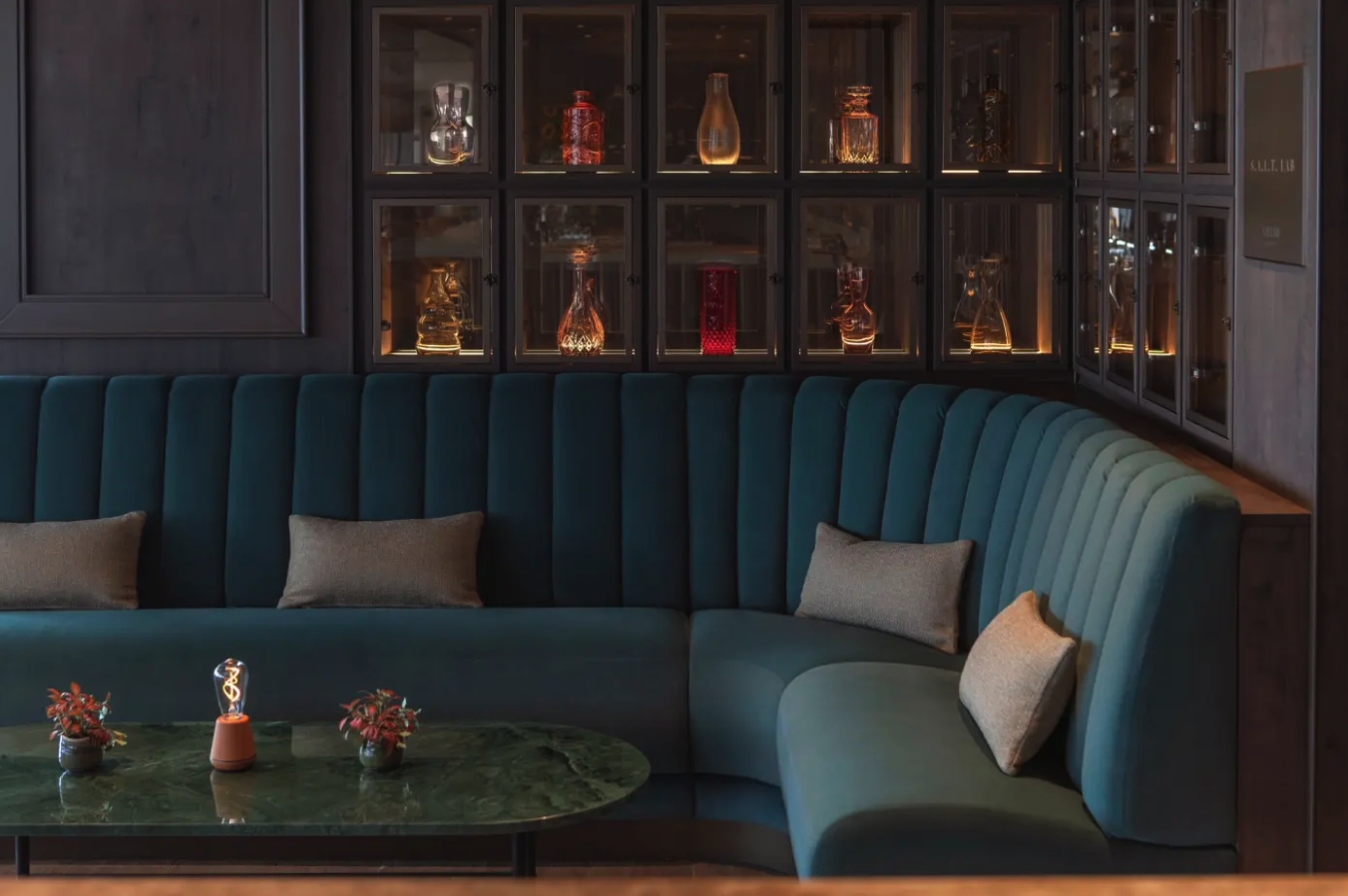
Nothing says authentic experience better than Silver Nova’s S.A.L.T. Bar. Get a taste for the authentic and settle down to enjoy locally-inspired cocktails and drinks. How can you go wrong with a Rum Punch in Barbados, a Pastis over ice in Marseille or a Pisco Sour in Lima? Nothing unites new faces and old friends in quite the same way. Be inspired to find your perfect locally-inspired beverage at the S.A.L.T. Bar and let in the colour and flavours of your journey rush in.
Images are intended as a general reference. Features, materials, finishes and layout may be different than shown.
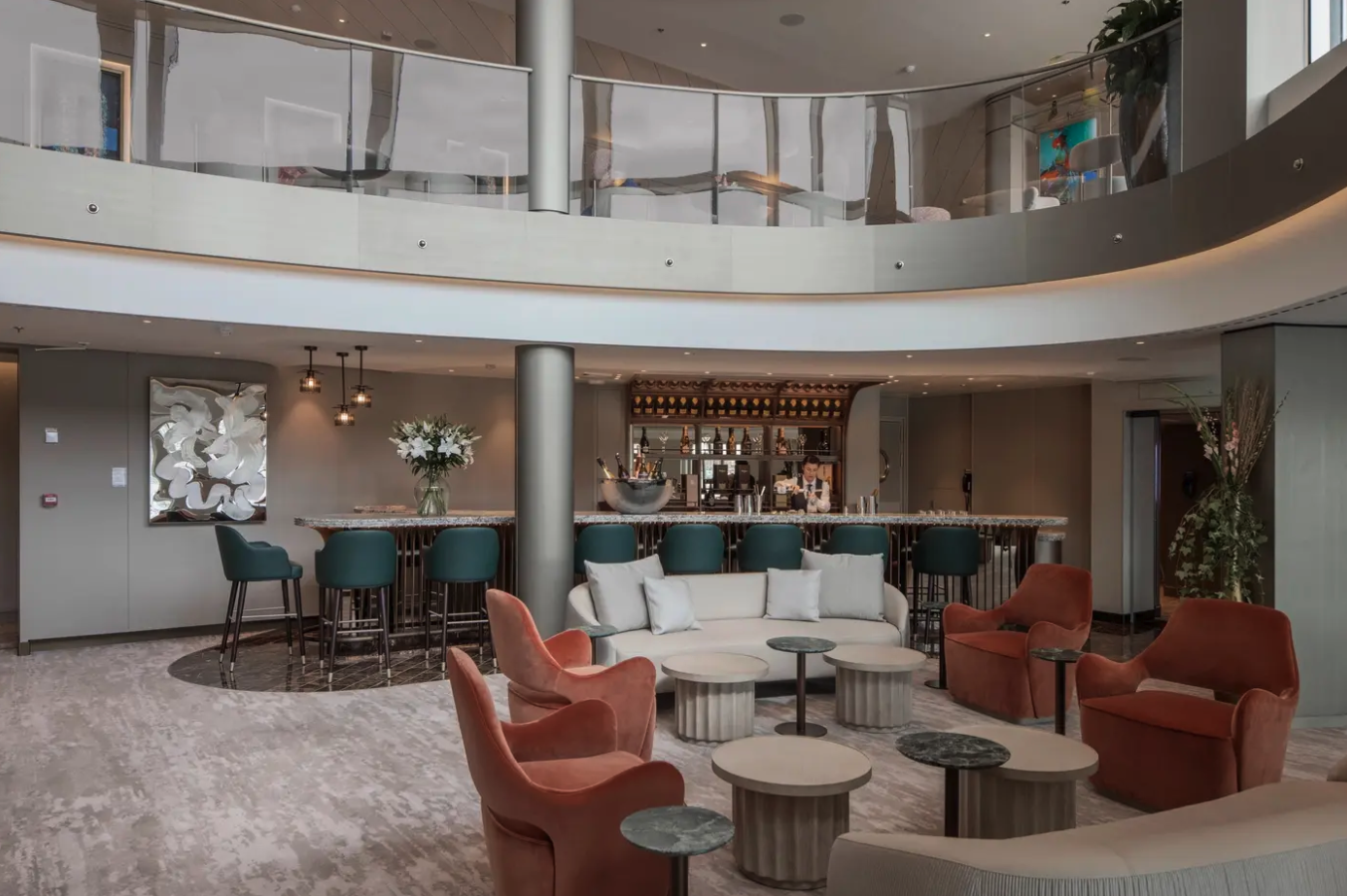
The Shelter is our newest pre and post dinner cocktail venue. Settle in amid an intimate and elegant setting, resplendent with sophisticated lighting, inviting sofas and stunning wraparound bar. Strategically located on deck three, the atmospheric hideaway opens onto the Atrium, creating an openness and connection to the other neighbouring venues. We promise you’ll fall in love with one of the best bars on board while our talented team of mixologists mix and shake our range of signature and bespoke cocktails. With itis the perfect destination, warm smiles and legendary Silversea service, get set for unforgettable nights in The Shelter.
Images are intended as a general reference. Features, materials, finishes and layout may be different than shown.
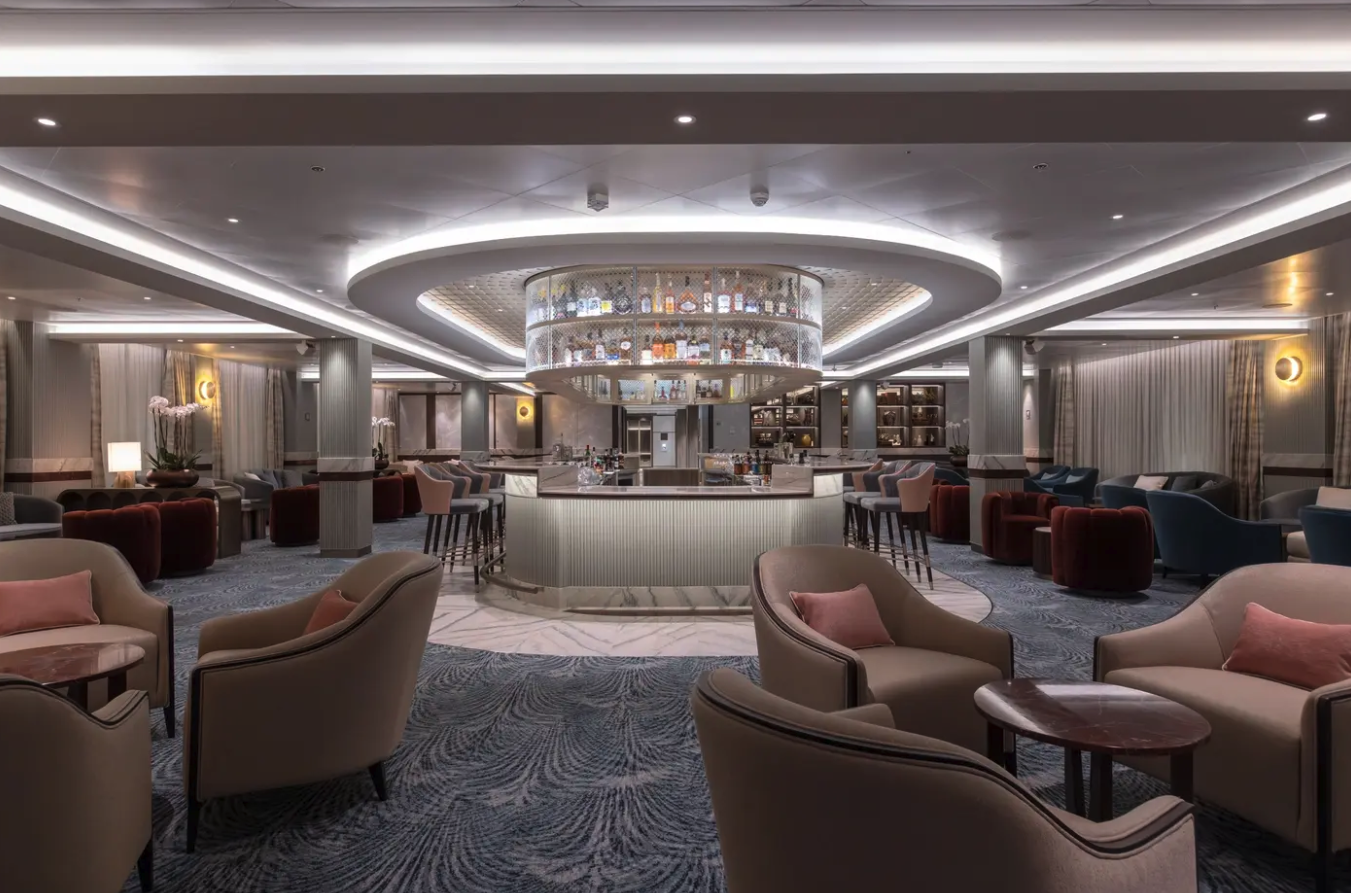
Our main bar has been newly reimagined for Silver Nova! Dolce Vita has of course kept her legendary charm, inspired cocktails, stylish décor and comfortable seating, but a central bar now means the warm ambience is better than ever! Oozing Italian glamour, Dolce Vita is a relaxed, refined bar with a nightly piano player playing all your favourite tunes. Perfect for pre-dinner aperitivi, or even a post-dinner cocktail, Dolce Vita is truly the beating heart of social life on board.
Images are intended as a general reference. Features, materials, finishes and layout may be different than shown.
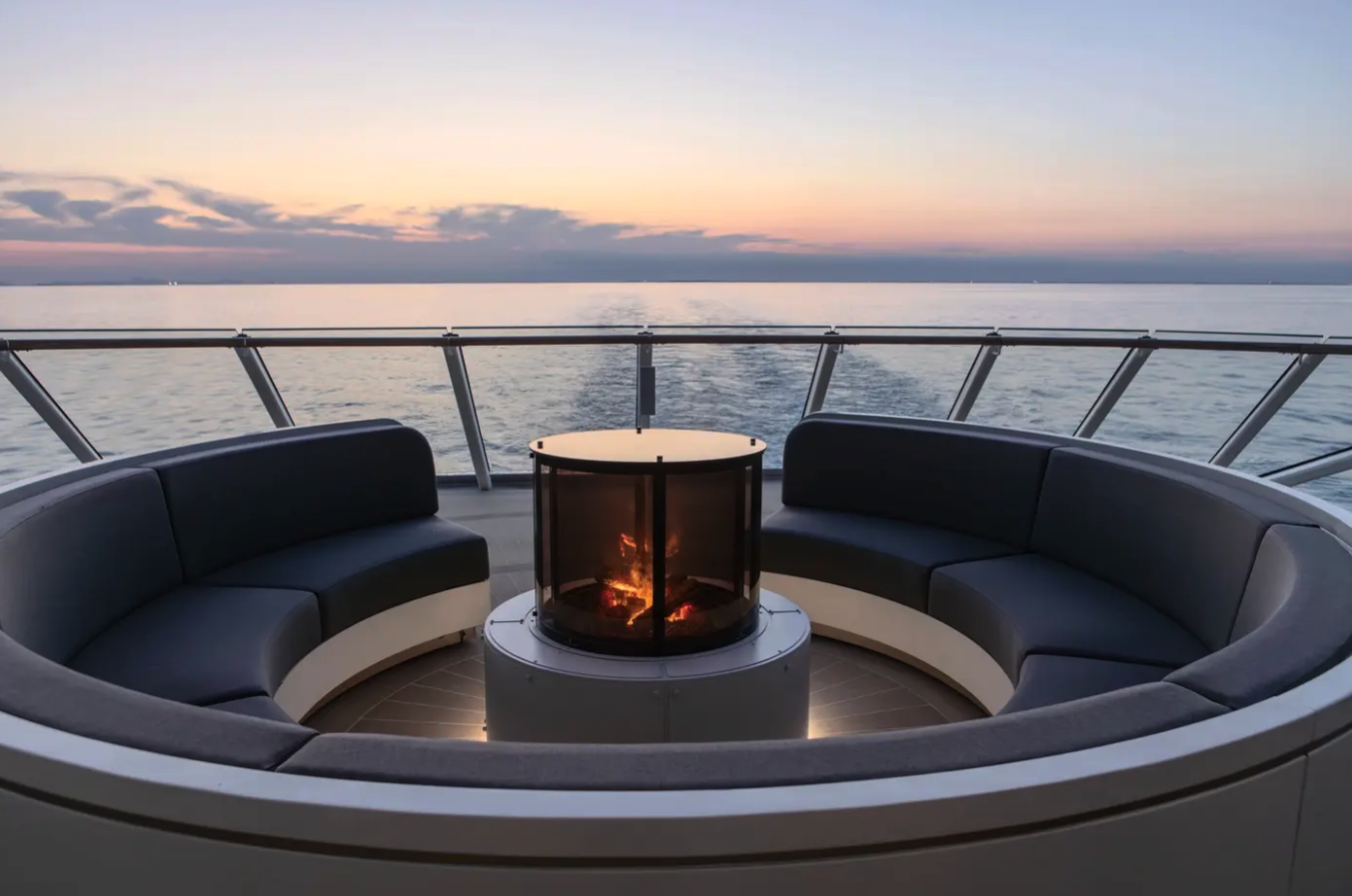
From early morning to late at night, the Panorama lounge offers everything you could wish for. A peaceful retreat that is the perfect place to break away to, a social place to meet and greet old friends, or an evening venue to partake in a cocktail as you sit back and watch the world go by. Sink into the plush seats and come evening, enjoy listening to the gentle sounds of a pianist, or the invigorating beats of our in-house DJ.
Images are intended as a general reference. Features, materials, finishes and layout may be different than shown.
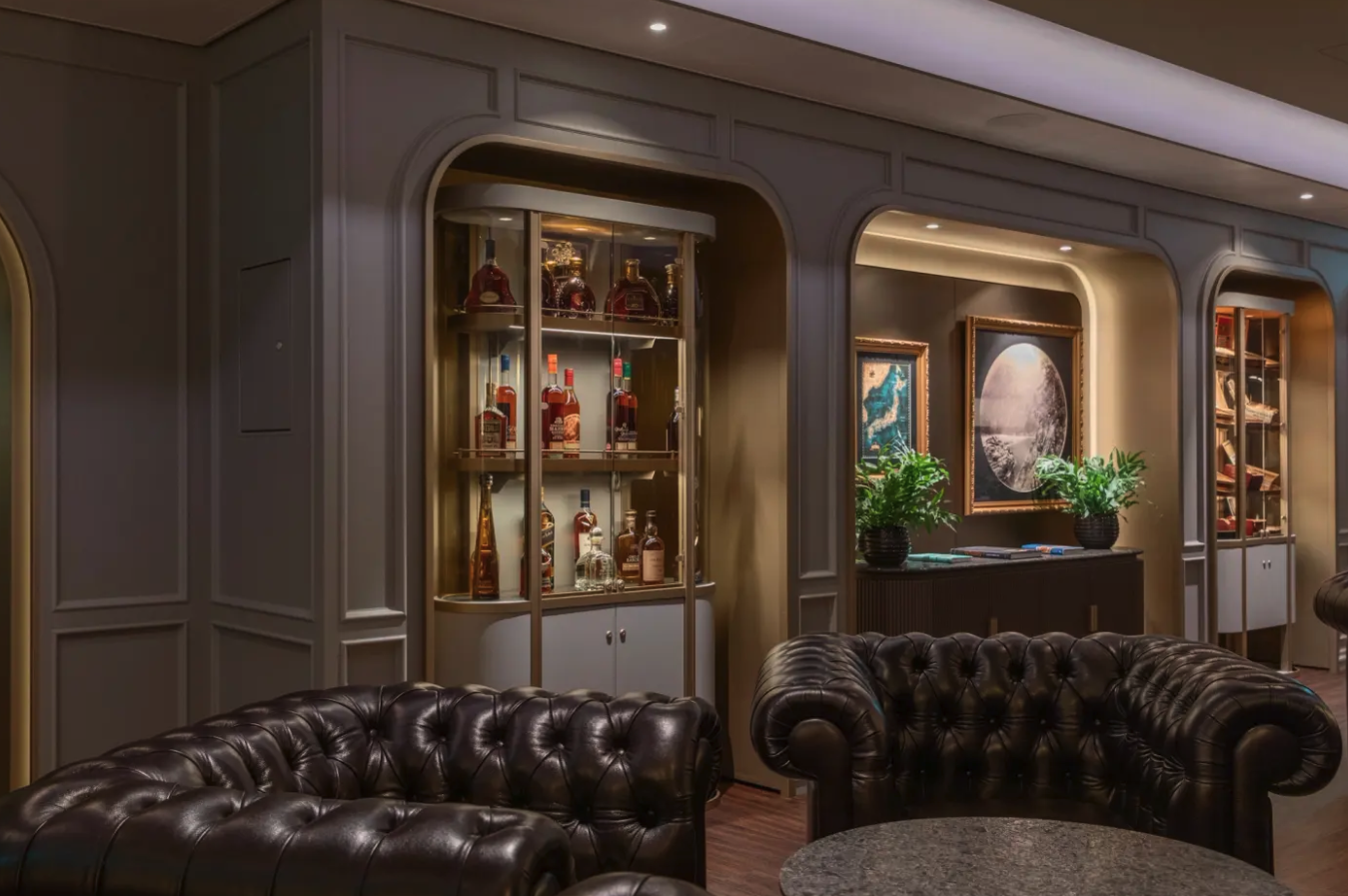
Our smoking lounge aboard Silver Nova is our latest venue where cigar-lovers can buy and sample some of the world’s finest Havanas, Cohibas, Partagás, Montecristos, Ramón Allones and Bolívars. Combining all the elements of cigar culture both indoors and on its stylish terrace, the Connoisseur’s Corner is where aficionados can meet and mingle to share their iconic passion.
Images are intended as a general reference. Features, materials, finishes and layout may be different than shown.
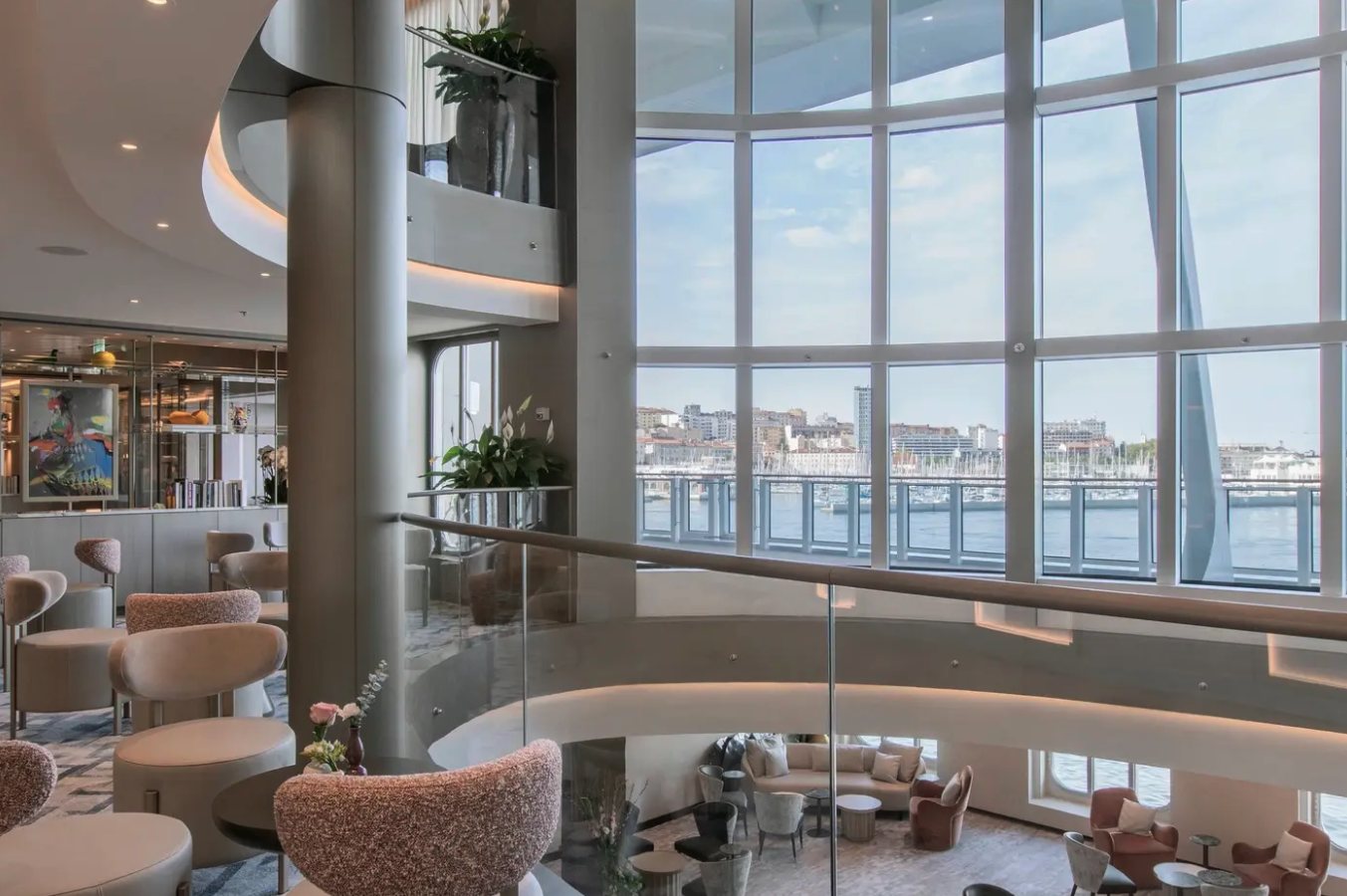
Located on deck 4, the Atrium is the beating heart of Silver Nova. Inspired by Roman architecture, The Atrium magnificent windows floods our central meeting areas with abundant natural light. The area is home to both the Arts Café and The Shelter, as well as main service areas such as the Reception, Shore Concierge and Future Cruise Sales. The Atrium’s enormous glass wall stretches over two decks, guaranteeing a deep connection with your destination whether at sea or docked in port.
Images are intended as a general reference. Features, materials, finishes and layout may be different than shown.

Set on the highest level at the very top of the ship, this is a quiet space for reading and reflection while being dazzled by the undulating seascapes that are constituent to life on board. Borrow a book from the in-house library, read the papers or just embrace the tranquillity of being at sea.
Images are intended as a general reference. Features, materials, finishes and layout may be different than shown.
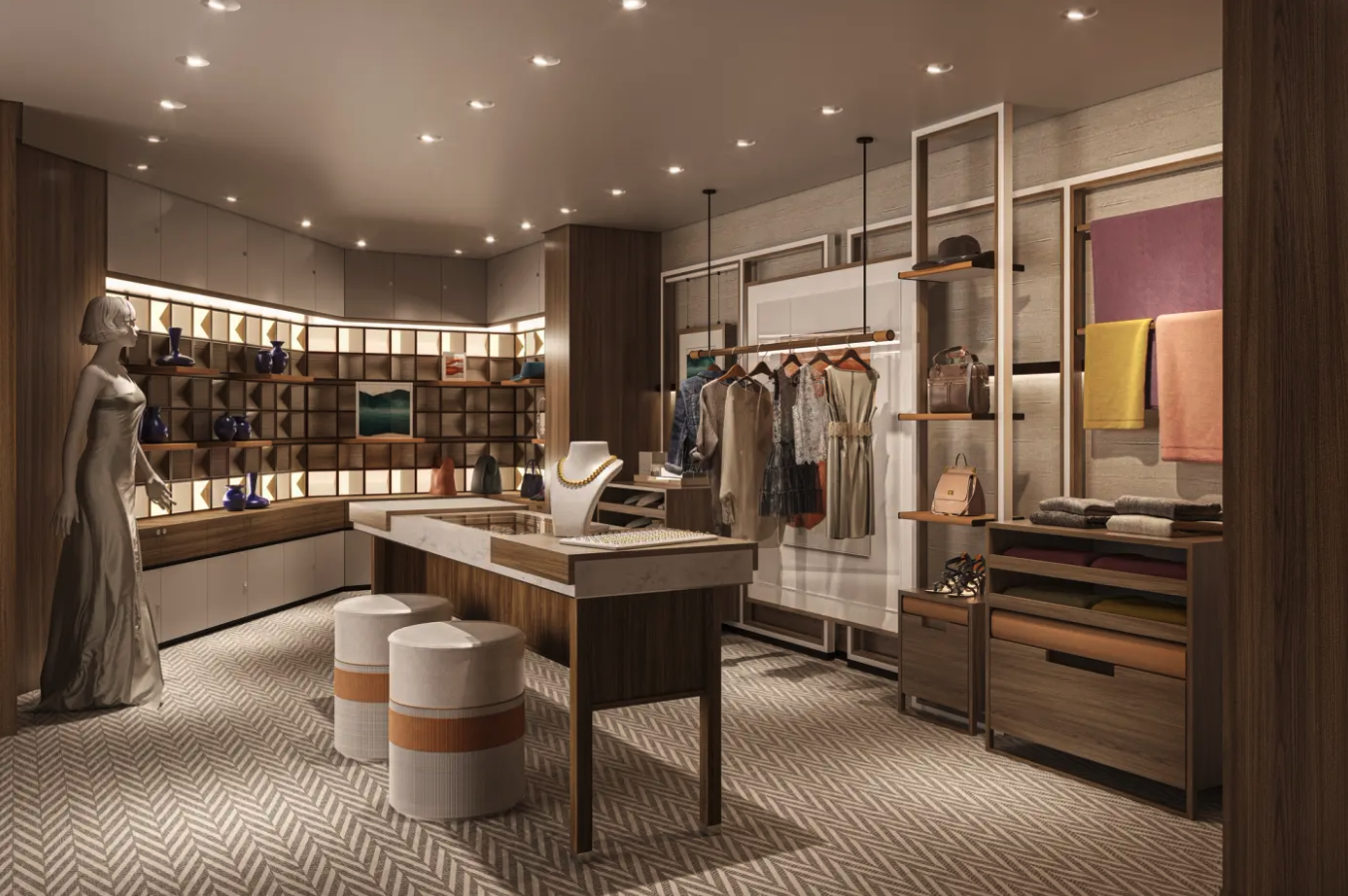
Exceptional shopping experiences do not end in the cosmopolitan cities we visit. Silversea’s striking new shipboard boutiques, reimagined and redesigned are stunning modern design spaces befitting the finest creations from legendary designers. Carefully selected partners onboard Silversea’s duty-free boutiques offers our guests a carefully curated selection of cutting edge fashions, jewellery, accessories, fine perfumes, cosmetics and Silversea Logo collection all at duty-free prices.
Images are intended as a general reference. Features, materials, finishes and layout may be different than shown.
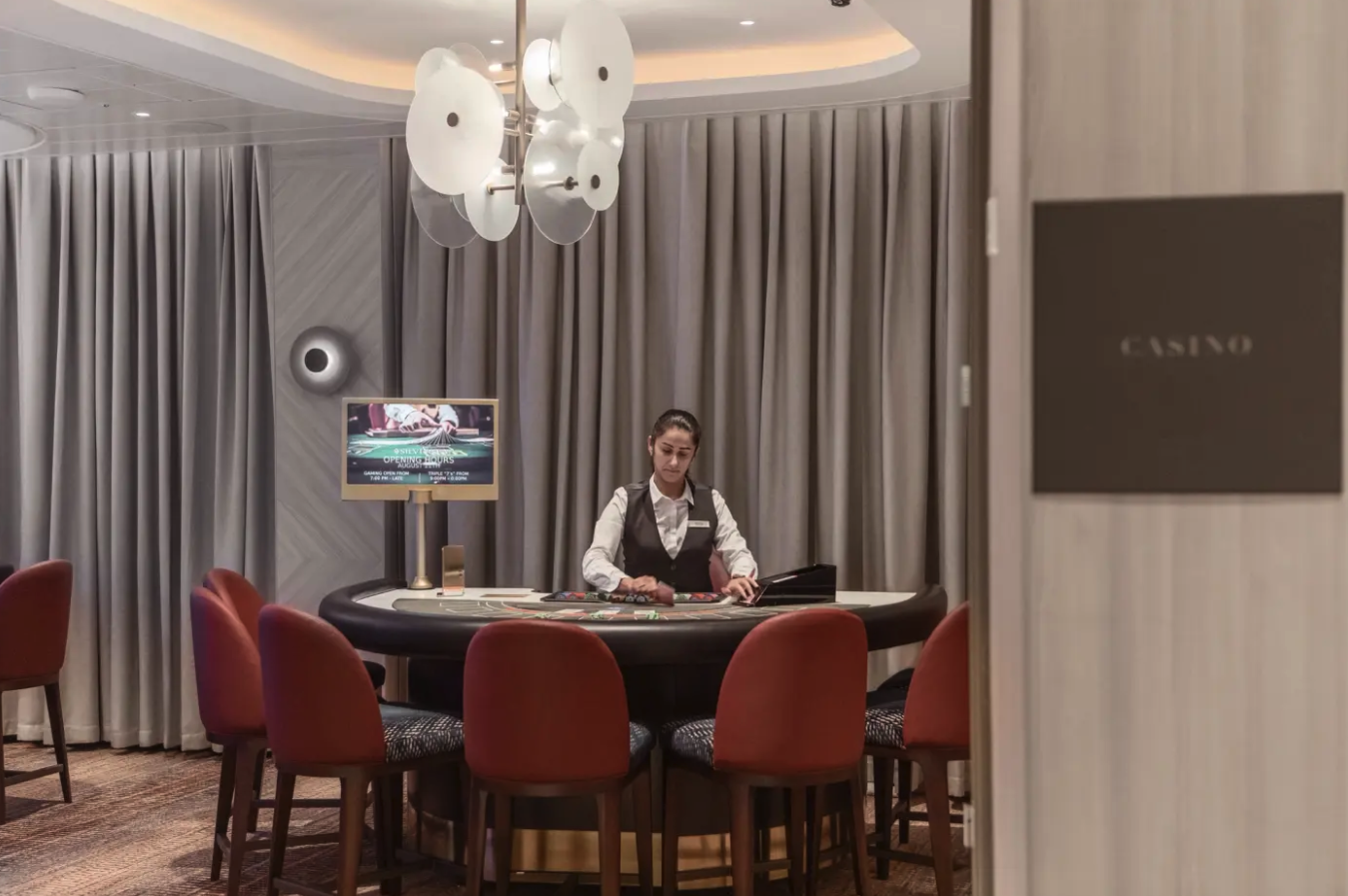
Let the fun begin! Channel your inner James Bond and enjoy a flutter at a variety of table games including American Roulette, Blackjack and Poker as Silver Nova glides silently through the waves. An assortment of multi-game, multi-denominational reel and video slot machines are also available. Prepare yourself for a luxurious and exhilarating experience with every turn of a card and spin of the wheel. Game on!
Images are intended as a general reference. Features, materials, finishes and layout may be different than shown.

The grandeur and magic of music and theatre. The experience of being transported by performance. That satisfying feeling of seeing an evening show … Welcome to Venetian Lounge, a place where the arts of theatre and music meet with full-scale productions and feature films. Paying tribute to a golden age of glamour, Venetian Lounge offers belle-époque style cabaret seating, with intimate tables and chairs subtly placed between the rows of comfortable tiered banquettes. As the stage lights are dimmed, soak up the atmosphere, relax and enjoy a night of dazzling sights and sounds.
Images are intended as a general reference. Features, materials, finishes and layout may be different than shown.

Finding relaxation is one the of the principle aims of taking a cruise, so why not join us in the Otium Spa for guaranteed indulgence? Turn off your phone, slip on your robe and get ready for a bit of me time. Whether you need to unwind with a massage, perk up your skin with a facial or work up a sweat in sauna and steam room, Otium Spa offers the very latest in beauty therapy. Make every day a special occasion in Otium Spa.
Images are intended as a general reference. Features, materials, finishes and layout may be different than shown.

With state of the art Technogym® equipment, free weights and speciality classes, the Fitness Centre brings together elite design with programs that are specifically created for your body type and needs. With personal trainers available for individual sessions, training here is more a five-star experience for all levels of fitness and experience. And with the best view that you’ll ever get whilst working out, there are definitely no more excuses
Personal Trainers
With personal trainers available for individual sessions, training at sea is a five-star experience for all fitness levels. And with the best view you’ll ever get whilst working out, there are definitely no more excuses not to keep fit on board. Personalised training, body composition analysis and speciality classes are available for an additional charge.
Images are intended as a general reference. Features, materials, finishes and layout may be different than shown.
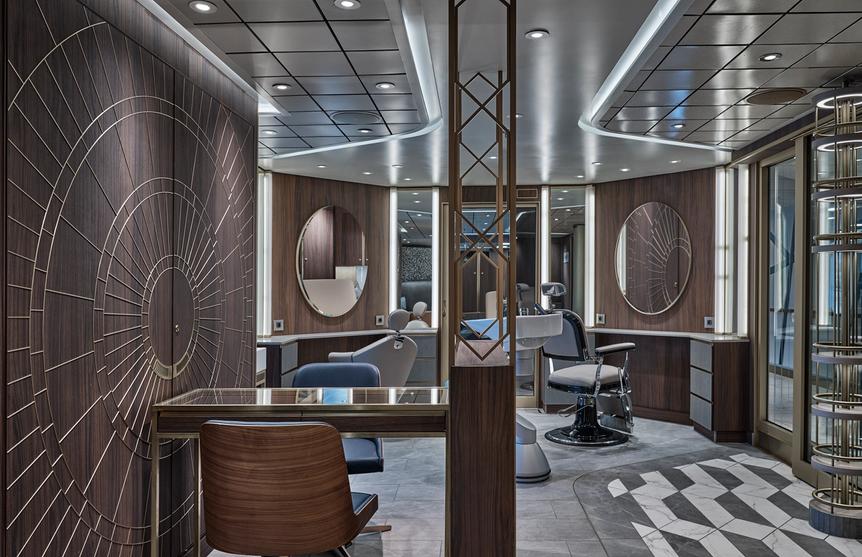
Hair and scalp conditioning treatments, colour protection and hair smoothing are just some of the highly effective salon services available onboard to help you. Our beauty therapists will look after you with manicures, pedicures, complete nail services, and professional teeth whitening. Gentlemen will not feel left out either with our luxurious shave and men’s grooming services.
At Silversea, the comfort, enjoyment and safety of all guests is paramount. To ensure a pleasant and safe environment, smoking is prohibited in most public areas, guest suites or suite balconies. However, cigarette, e-cigarette, cigar, pipe and vaporizer smoking is permitted in the Connoisseur’s Corner both indoors and outdoors (where applicable). In addition, cigarette, e-cigarette and vaporizer smoking is permitted in specifically designated outside areas and tables:
- Silver Nova, Silver Ray: Dusk Bar (port side);
- Silver Muse, Silver Spirit: Panorama Lounge (port side) and Pool Grill (port side);
- Silver Moon, Silver Dawn: Panorama Lounge (starboard side) and Pool Grill (port side);
- Silver Shadow, Silver Whisper: Panorama Lounge (starboard side) and Pool Grill (starboard side);
- Silver Cloud, Silver Wind: Panorama Lounge (port side) and Pool Grill (port side);
- Silver Origin: on open deck 4 aft;
Silversea kindly requests that all guests observe the non-smoking areas.
Each Silversea ship is equipped with a Medical Centre, which is staffed by a doctor and nurse on 24-hour call when at sea. When docked, supplementary emergency care may also be obtained through local medical facilities. Guests may be charged for medical services and for medications used for their medical treatment. The Medical Centre is not intended or designed to provide on-going treatment of pre-existing conditions or for extended critical care, and Silversea is not responsible for the diagnosis, treatment or services furnished by shipboard medical personnel.
If you have special dietary requirements, Silversea will make every attempt to accommodate your requests. Please advise Silversea of your needs on the Guest Information Form at least 75 days prior to sailing. Notification should be sent to specialservices@silversea.com
Wheelchair guests must bring their own collapsible wheelchair. Please note that not all shore excursions are suitable for guests with impaired mobility. Silversea strongly recommends wheelchair guests travel with someone who is able to assist them both ashore and at sea as Silversea may be unable to offer special assistance. Please note that wheel-on and/or wheel-off access may not be available at some ports-of-call. Silversea reserves the right to deny boarding to any guest who failed to notify Silversea of such requirement at the time of booking.
All guests are required to report in writing to Silversea at the time their reservation is made:
- Any physical or mental condition that may require medical or professional treatment or attention during the voyage
- Any condition that may render the guest unfit for travel, or that may require special care or assistance
- Any condition that may pose a risk or danger to the guest or anyone else on board the ship
- Any condition that may require oxygen for medical reasons
- Any intention or need to use a wheelchair aboard ship.
Complete valet services, including laundry, pressing and wet cleaning, are available at an additional charge and may be arranged through your butler. Laundry service is complimentary for certain suite categories and for those Venetian Society members who have reached certain reward levels. A self-service launderette offers washing machines, dryers, irons and laundry supplies, allowing you to limit the amount of cruise luggage needed, especially for longer voyages.
All Silversea ships are equipped to offer wireless (Wi-Fi) Internet access. You can use your own laptop to surf the Internet and check emails at Wi-Fi locations throughout the ship, or from the comfort and privacy of your suite. Computers, email and Internet access are also available on board at the Internet Café. However, it is important to understand that telecommunication services while at sea are via satellite and significantly different than high-speed connections on land back home. The signal travels in a similar manner to radio waves but at much greater distances. Therefore, onboard Internet access is not guaranteed at all times. Satellite communications are also affected by weather and the ship’s location. In particular, Internet service is extremely sporadic while in the Arctic. Guests aboard expedition cruises to/from Svalbard should be prepared to be out of communication for the duration of their time on board. (Please be assured that Silver Explorer always has emergency communication capabilities.)
Silversea cruise guidelines state that children under the age of 18 must be accompanied, in the same or connecting suite, by a parent or other responsible adult over the age of 21 for the duration of the voyage. If the adult accompanying the minor is not their parent, a parental consent guardianship form must be signed by a parent or legal guardian and received by Silversea prior to sailing. Please contact our Special Services Department at SpecialServices@Silversea.com for a Parental Consent Form. Guests must be 21 years of age or older to purchase or consume alcohol. Silversea reserves the right to refuse to serve anyone who in its sole judgment may be under the influence of alcohol, or for any reason necessary in its judgement to preserve the health and safety of guests and employees.
Silversea cannot accommodate infants less than six months of age and reserves the right to limit the number of children less than three years of age (Silver Explorer, Silver Cloud and Silver Wind cannot accommodate infants under the age of 1 year, Silver Origin cannot accommodate children under the age of 5 years). Parents are required to sign a notarised waiver prior to sailing in order to grant a valid booking for children ages between 6 months and 1 year old. A signed and notarised waiver will be required for all children between these ages. Although Silversea accepts guests over the age of 6 months (over the age of 1 year for Silversea Expeditions), there are no special programmes for children on board our luxury cruise ships, and Silversea does not provide for the care, entertainment or supervision of children. Silversea reserves the right to limit the number of children less than 3 years of age.
Children under the age of 8 years old are only permitted to participate in suitable Silver Shore Excursions / shuttle service if the vehicles are equipped with the correct safety harness and seating equipment. Child harnesses and secure seating cannot be guaranteed. Silversea reserves the right to refuse children under the age of 8 years old on any tour on the basis of safety. Guests may use their own approved safety seat, booster seat or harness provided they are compatible with the local touring vehicle and can properly secure the child.
In addition, the Zodiacs used for Silversea Expeditions are unable to accommodate children younger than 5 years of age. As Silversea does not provide babysitting services, an adult family member will be required to remain on board with their child(ren) during Zodiac excursions.
During the day, casual wear, similar to five-star resort sportswear, is suitable for most activities. It is recommended to wear flat or low-heeled shoes on deck.
After 6 pm, our Evening Dress Code applies; jeans, shorts, sneakers, or flip-flop-type footwear are prohibited in indoor spaces.
TWO EVENING TYPES:
1. Elegant Casual
Ladies may opt for trousers, a blouse, skirt, or casual dress. Gentlemen may wear an open-collar shirt and slacks. A jacket is optional.
2. Formal Optional
Ladies may choose an evening gown or cocktail dress. Gentlemen should wear a tuxedo, dinner jacket, or dark suit with a tie. Adhering to our Elegant Casual dress code is also welcomed, but a jacket is still required for gentlemen when indoors
FORMAL OPTIONAL NIGHTS PER SAILING:
- 7 days or less – No Formal Optional night
- 8 to 14 days – 1 to 2 Formal Optional nights
- 15 days or more – 2 or more Formal Optional nights
Onboard Silver Nova we take care of everything, including the environment.
The ocean ecosystem is our home. It’s also how we reach our stunning destinations. However, it’s as fragile as it is vast/ With Silver Nova, we’re introducing a new way of looking at sailing, at the environment, at the ocean itself. Thanks to her, state-of-the-art technologies, Silver Nova is one of the most sustainable cruise ships ever build: a true reflection of our deep commitment to the oceans, the environment and the communities we find at each of our splendid destinations.
Higher efficiency. Cleaner sailing.
Silver Nova was designed from her backbone to lower her environmental impact as much as possible, starting with the carbon footprint for her construction. Her hull was designed to increase dynamic efficiency and minimise fuel consumption. She also incorporates state-of-the-art technologies to reduce onboard waste, such as the newly-developed Micro Auto Gasification System (M.A.G.S.), resulting in lower incineration emissions, and a Waste Heat Recovery System which allows the ship to reuse waste heat (ie. from the absorption chillers) for even more energy efficiency. Furthermore, she’s equipped with Shore Power, a feature that allows Silver Nova’s main generators to be shut down and the ship plugged into the onshore energy supply where available, cutting emissions while in port.

- The Cliff Whirlpool
- Sun Deck
- Elevator

- Observation Lounge
- S.A.L.T. Lab
- S.A.L.T. Bar
- Pool Deck
- Pool Bar
- Library
- The Marquee
- (The Grill & Spaccanapoli)
- The Dusk Bar
- Jogging Track
- Elevator

- Junior Grand Suite
- Classic Veranda Suite
- Superior Veranda Suite
- Premium Veranda Suite
- Medallion Suite
- Deluxe Veranda Suite
- Master Suite
- Signature Suite
- Premium Medallion Suite
- Elevator

- Class Veranda Suite
- Silver Suite
- Medallion Suite
- Superior Veranda Suite
- Premium Veranda Suite
- Deluxe Veranda Suite
- Owner’s Suite
- Master Suite
- Premium Medallion Suite
- Signature Suite
- Elevator

- Grand Suite
- Classic Veranda Suite
- Medallion Suite
- Silver Suite
- Superior Veranda Suite
- Premium Veranda Suite
- Deluxe Veranda Suite
- Otium Suite
- Premium Medallion Suite
- Master Suite
- Signature Suite
- Elevator

- Junior Grand Suite
- Classic Veranda Suite
- Medallion Suite
- Silver Suite
- Superior Veranda Suite
- Premium Veranda Suite
- Deluxe Veranda Suite
- Signature Suite
- Master Suite
- Otium Suite
- Elevator

- Otium Spa
- Fitness Centre
- Beauty Salon
- Casino
- Boutique
- Dolce Vita
- Silver Note
- Connoisseur’s Corner
- Panorama Lounge
- Elevator

- La Dame
- Venetian Lounge
- Boutique
- Reception
- Arts Café
- Shore Concierge
- Atrium
- Kaiseki
- La Terrazza
- Elevator

- Atlantide
- S.A.L.T. Kitchen
- The Shelter
- Elevator

